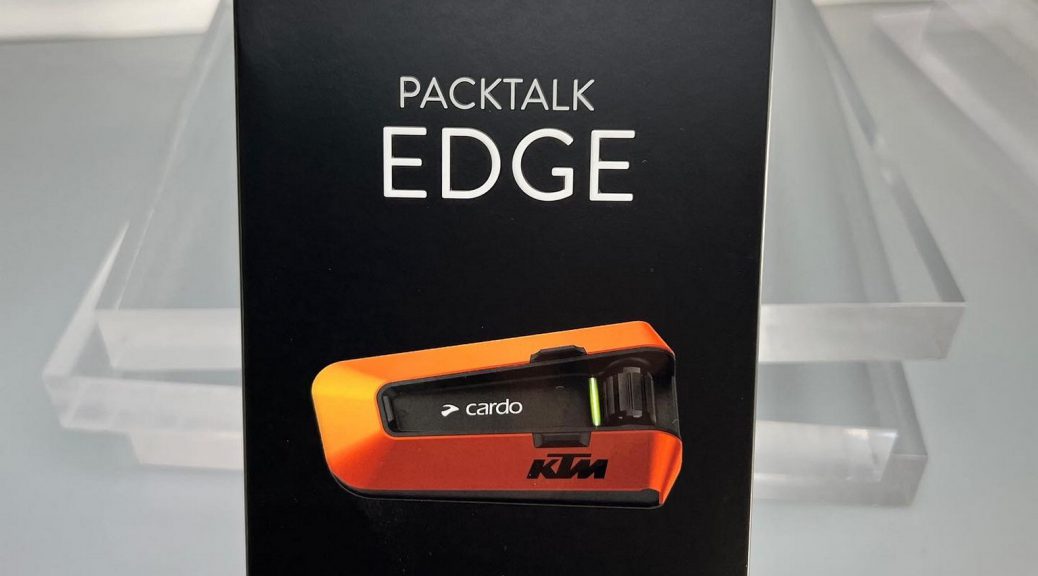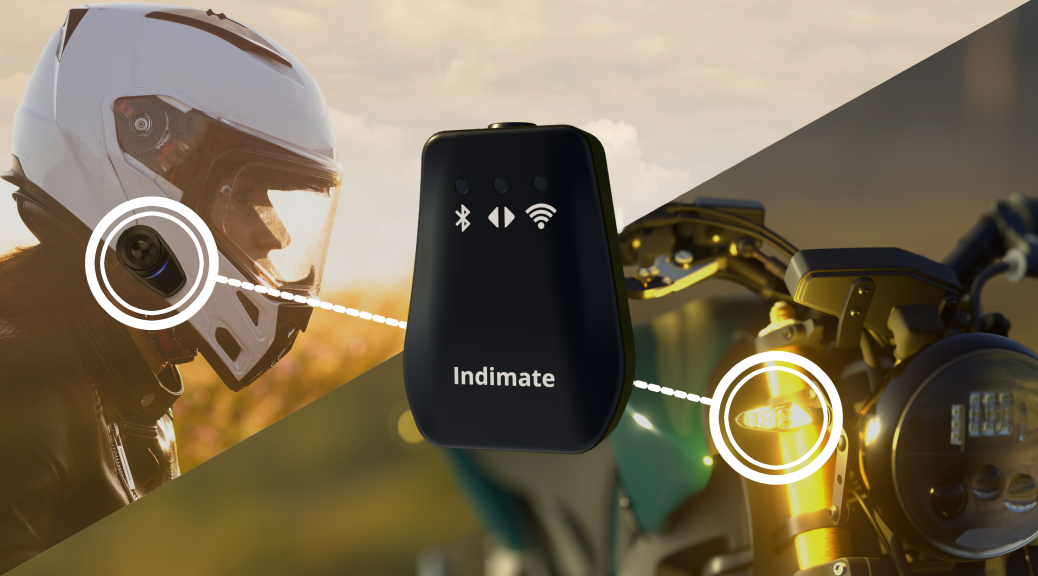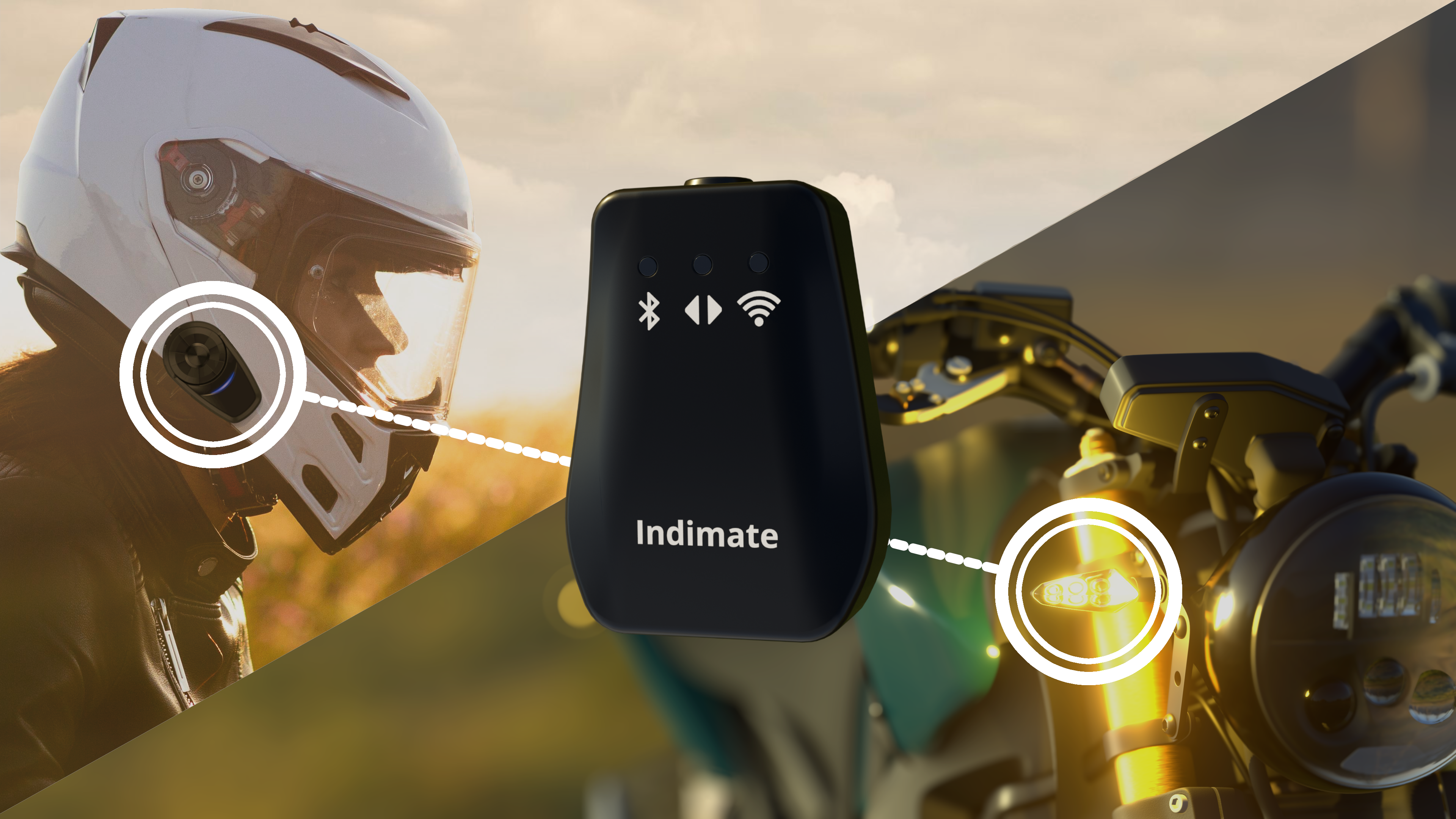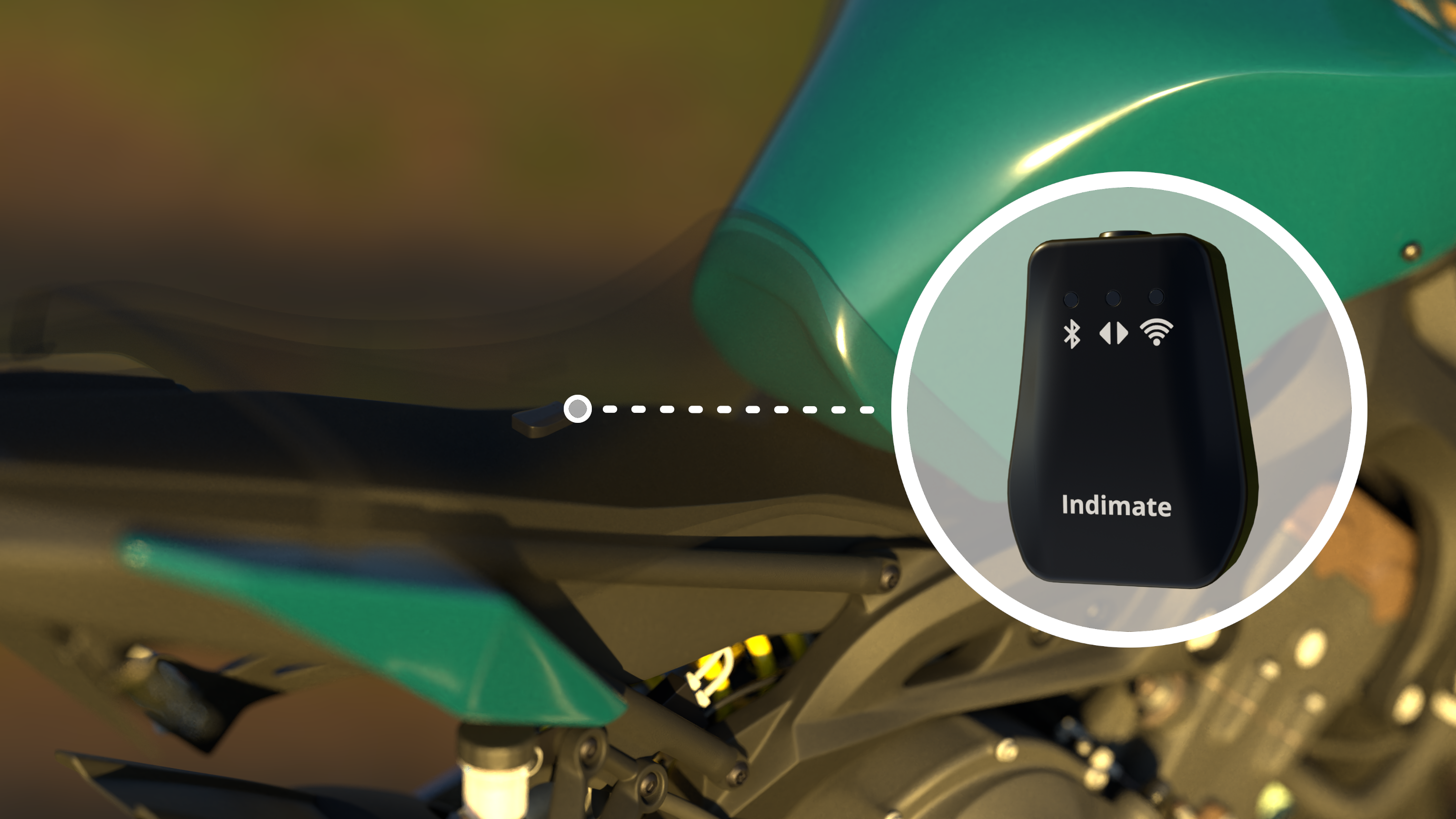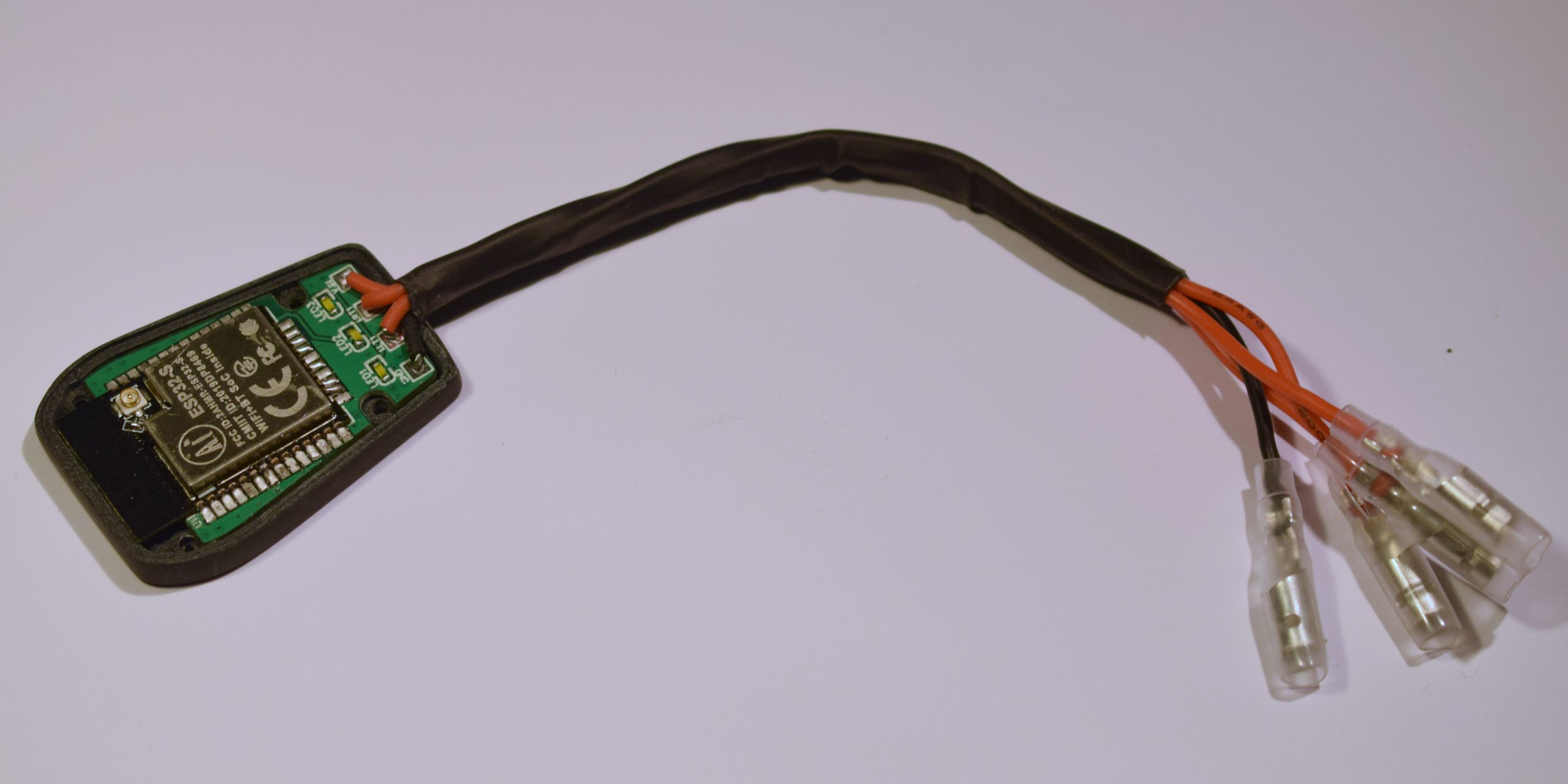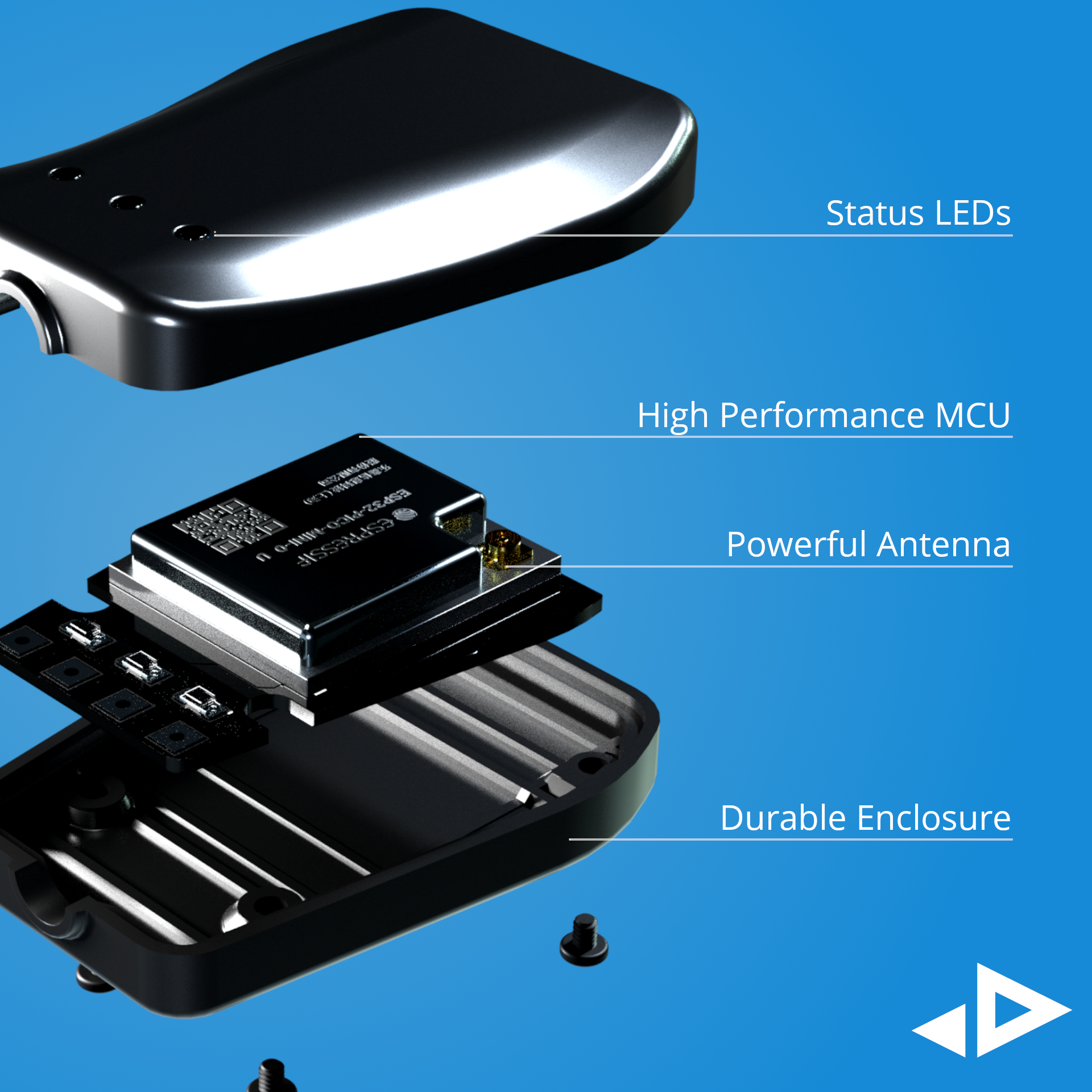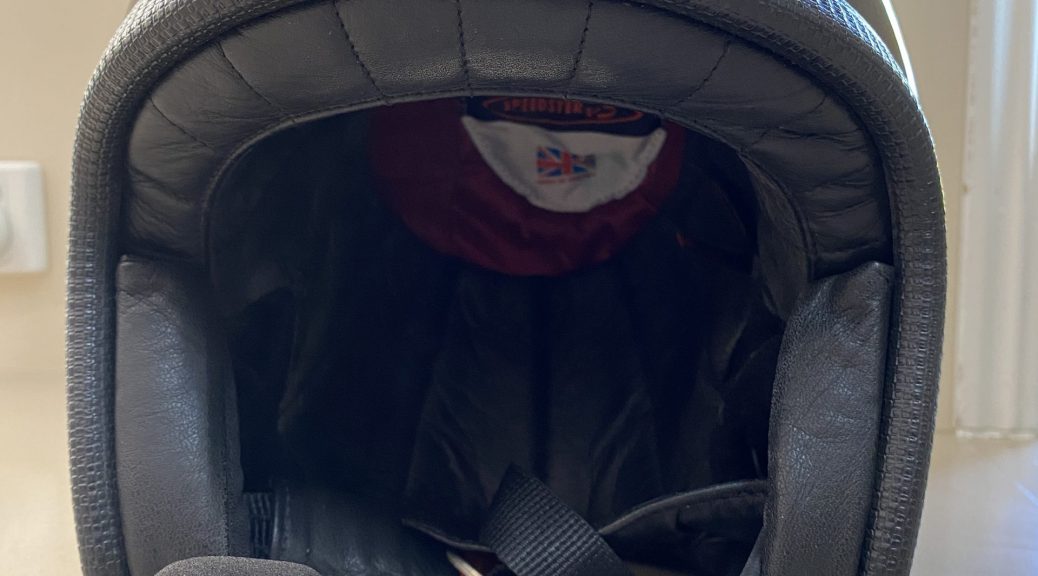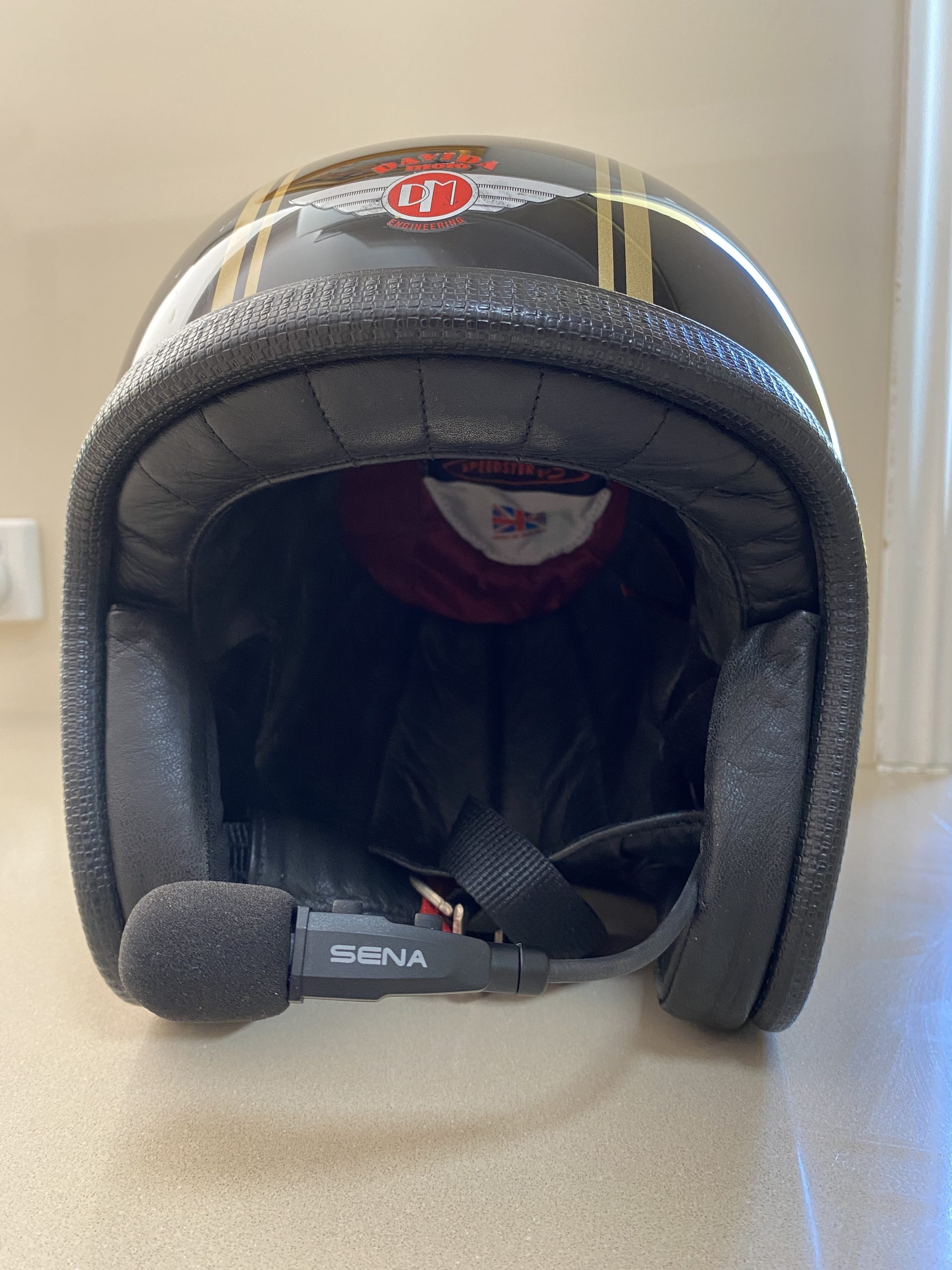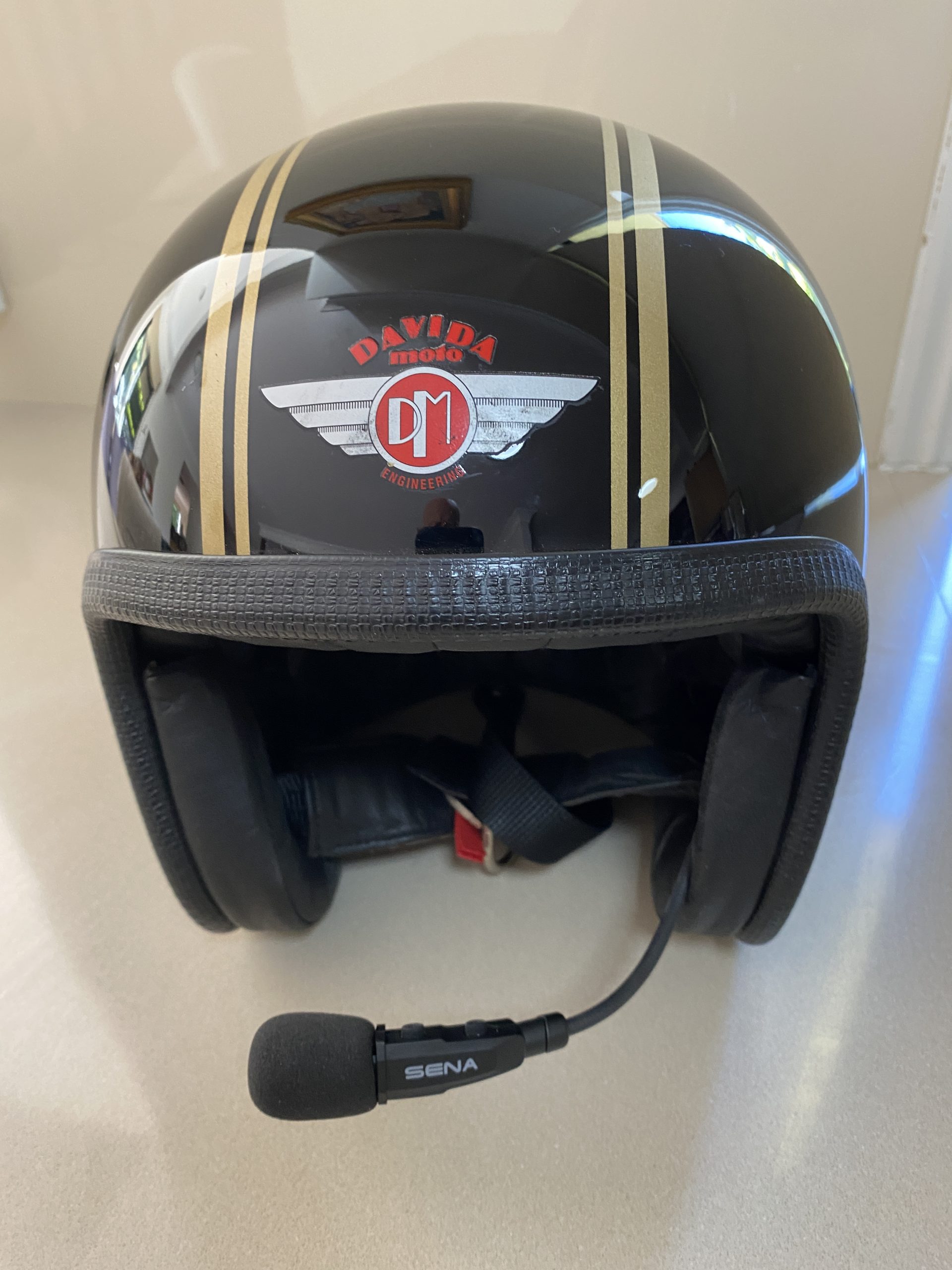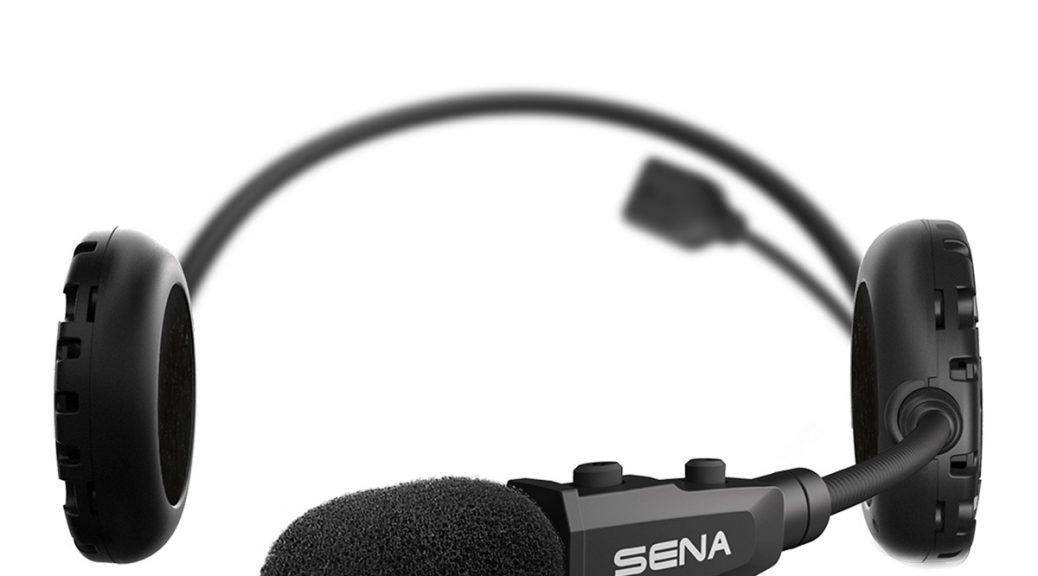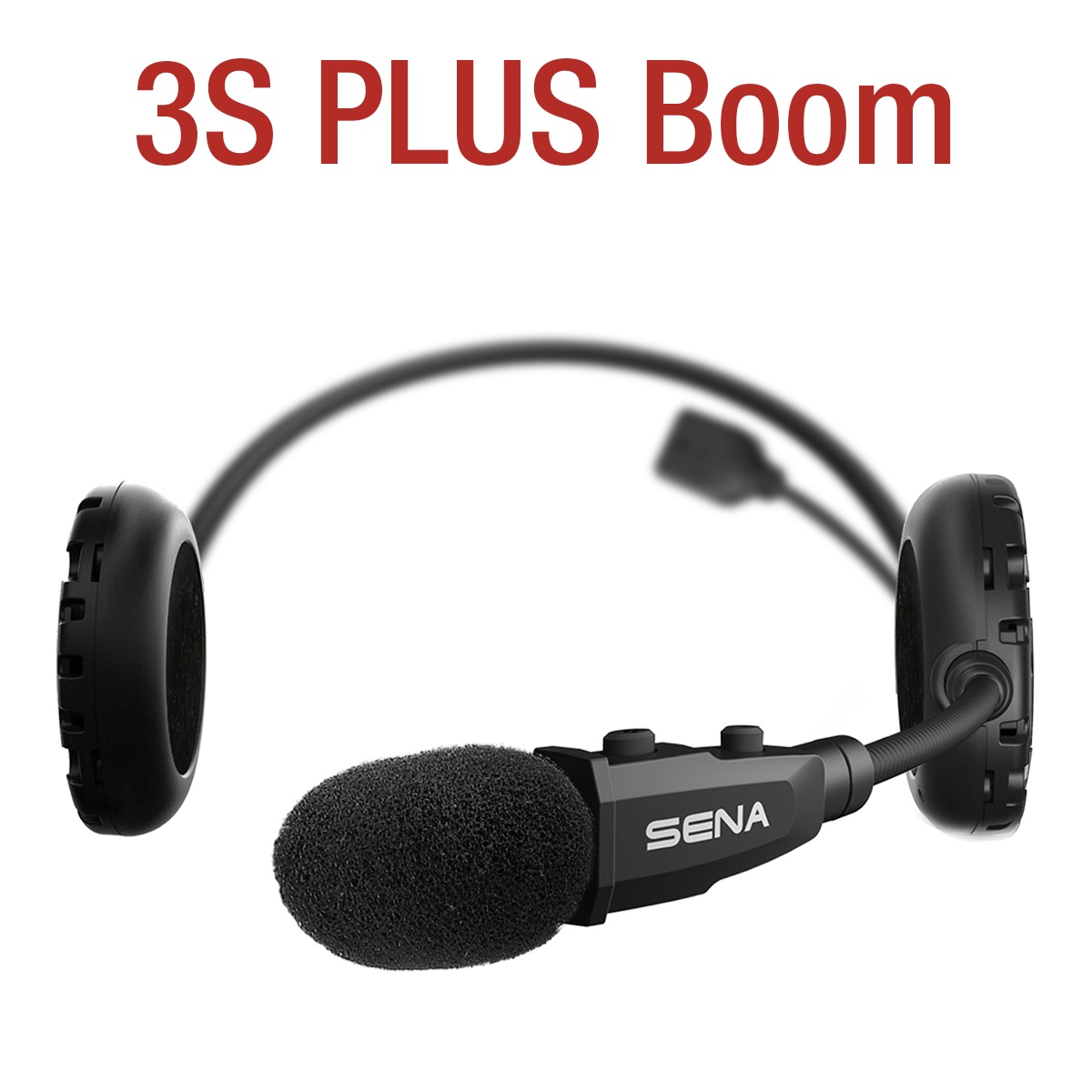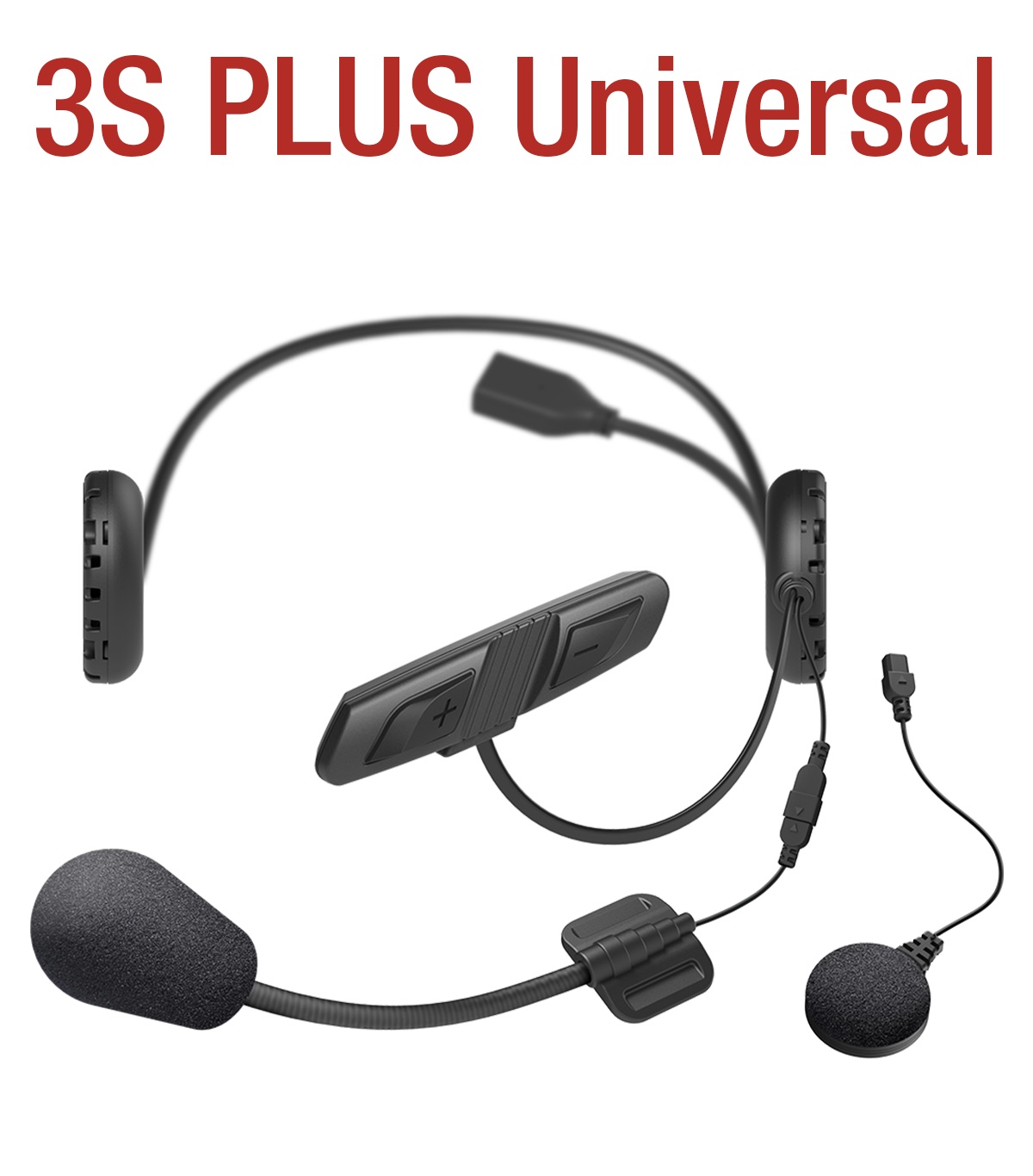This fancified Packtalk Edge isn’t just a pretty face either. It boasts excellent battery life, premium JBL speakers, Dynamic Mesh intercom, wireless firmware updates, and best of all, unmatched voice command control over all functions.
It’s expensive, still suffers from the occasional glitch or two, intercom audio interference can occur, and the Air Mount longevity is unknown, but overall I think this is the safest and the top in-helmet communicator I’ve used to date.
Review Summary:
- The Cardo KTM Packtalk Edge is a bluetooth helmet communicator with great battery life, premium speakers, and Dynamic Mesh technology. It also offers excellent voice control.
- The Cardo Packtalk Black offers many of the same features with a lower price tag, but the KTM Packtalk Edge is a superior device by virtue of its advanced technology like wireless firmware updates.
- It’s relatively expensive compared to other intercom systems, but if you’re looking for a premium helmet communicator, the KTM Packtalk Edge is one of the best we’ve ever reviewed. It’s also available in a Honda-branded version.
First Impressions of the KTM Packtalk Edge
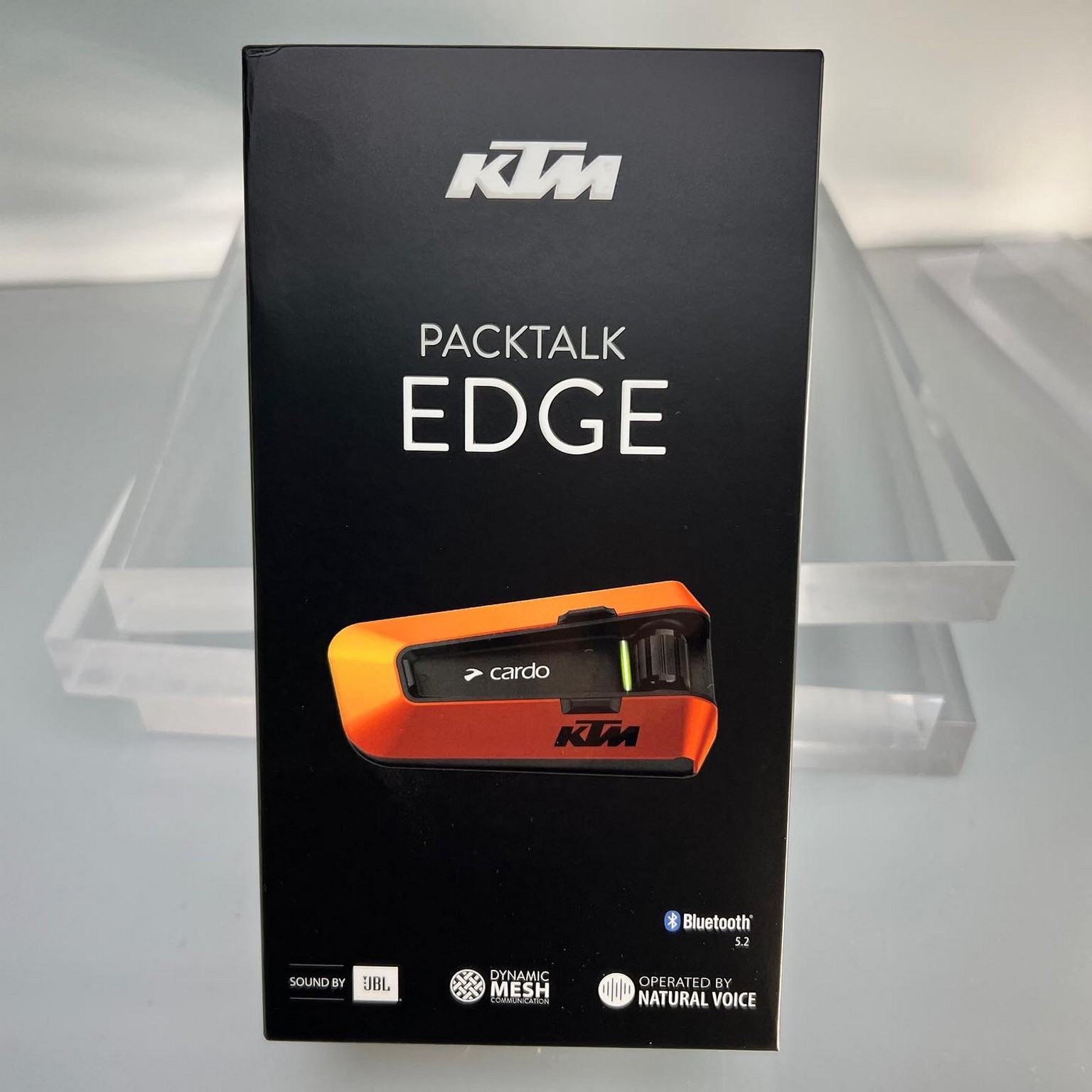
Open the box of the Cardo KTM Packtalk Edge and you’ll be dazzled by the eye-popping, bright orange housing this aesthetically enhanced communicator wears. The orange pops visually when compared to the comparatively drab grey-colored housing found on the base model Packtalk Edge.
As everyone knows, putting the KTM logo on anything adds 10% more horsepower, but detractors claim it also negatively affects reliability. For die-hard KTM riders, I’m sure that’s a price they’re willing to pay.
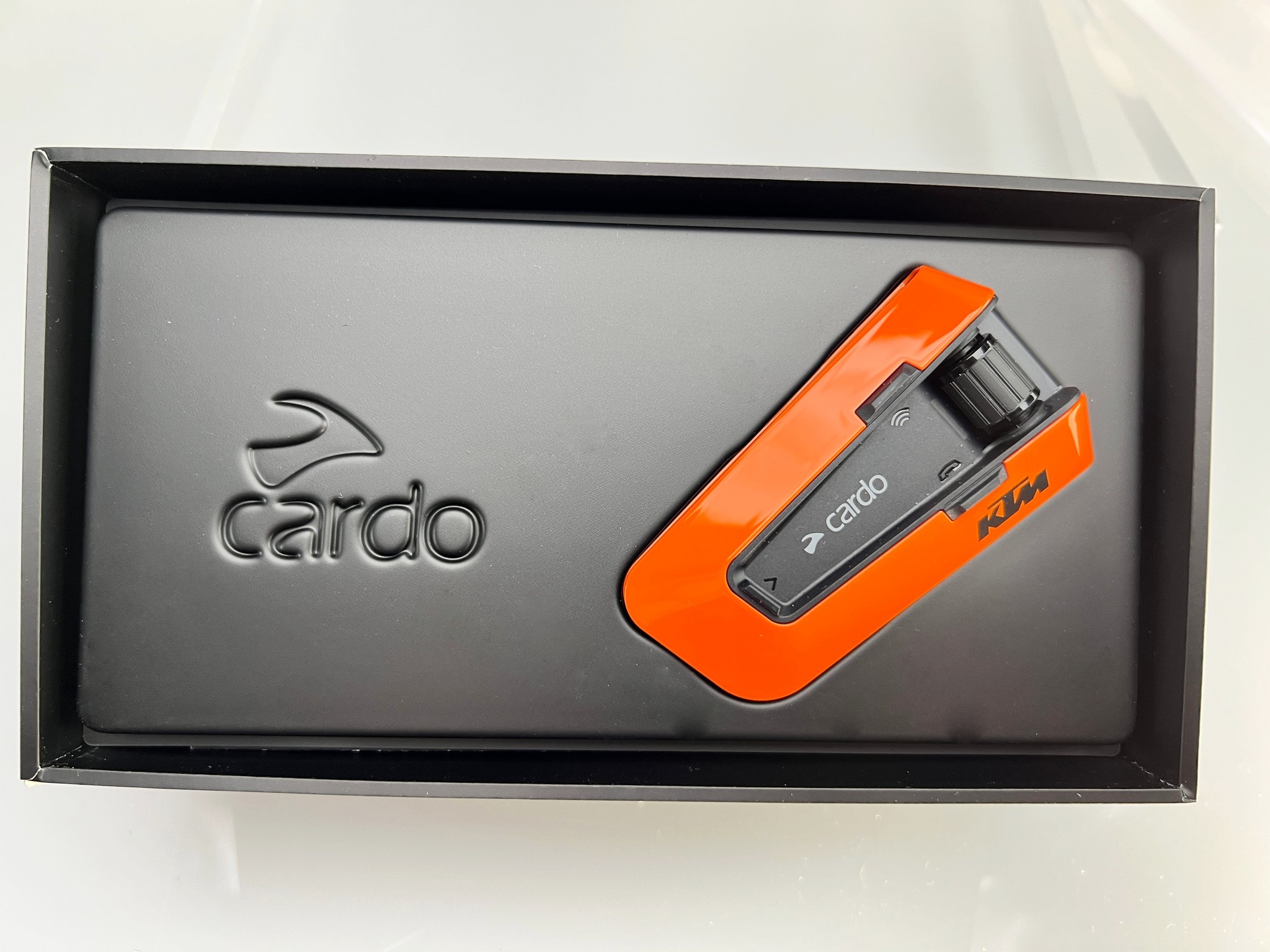
On a serious note, this device seems well-built, although everything I can touch on it is entirely made of plastic with a bit of rubber on the rotary switch and charging port cover. That makes it lightweight, but will it also be durable? Will it degrade and fall apart after long-term exposure to UV light, rain, cold, heat, dirt, dust, and mud? Is it even made for adventure riding?
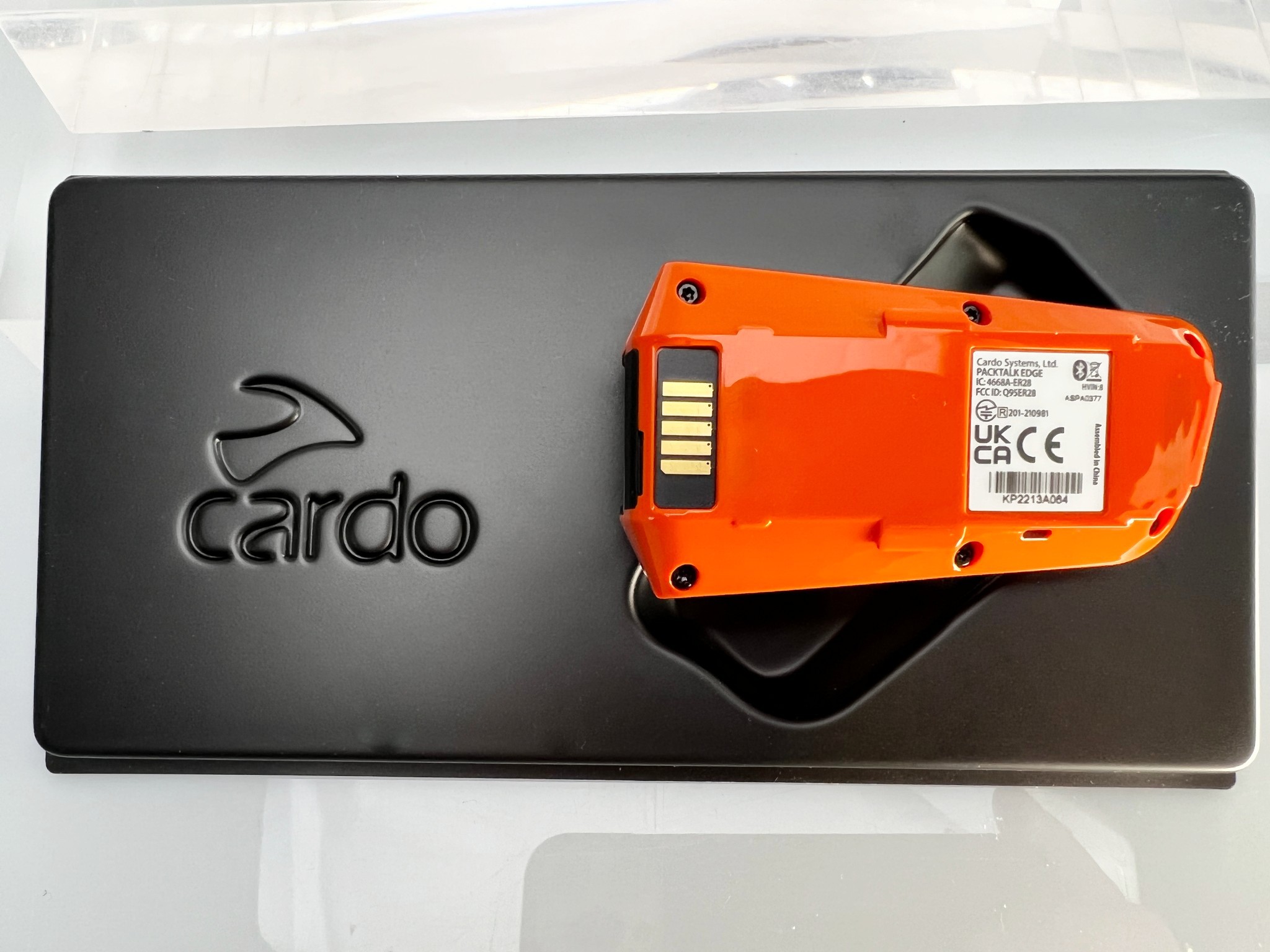
The Testing Conditions
In order to properly field test the KTM Edge, my plan was to take it on a long and taxing adventure trip in the real world. Specifically, on a 5000-mile (8100 km) ride from Canmore, Alberta, Canada southwards, keeping mainly off-road along the Continental Divide Trail before ending at the Mexico border in Antelope Wells, New Mexico. Montana, Idaho, Wyoming, Colorado, will all be featured as beautiful backdrops along the way as well.

That’s exactly how it went.
Temperatures during my testing ranged from a low of 41 Fahrenheit (5 Celsius) to a high of 102 Fahrenheit (39 Celsius). The KTM Edge braved high winds, plenty of dust, and heavy rain at times, but the elements proved inconsequential to its performance over the 18 days used to complete our journey.
Thank You Cardo!

Our Cardo contacts Kasey and Zach were so confident in the Edge they sent us 5 more base model devices at no cost to equip the rest of my riding group for this trip of a lifetime. This way we could not only stay safer by keeping the 6 of us connected verbally using the Dynamic Mesh intercom feature but also allowing a wider sample of the product for testing. In my mind, that yields more accurate results.
Installing the KTM Packtalk Edge in Different Helmets
Klim Krios Pro
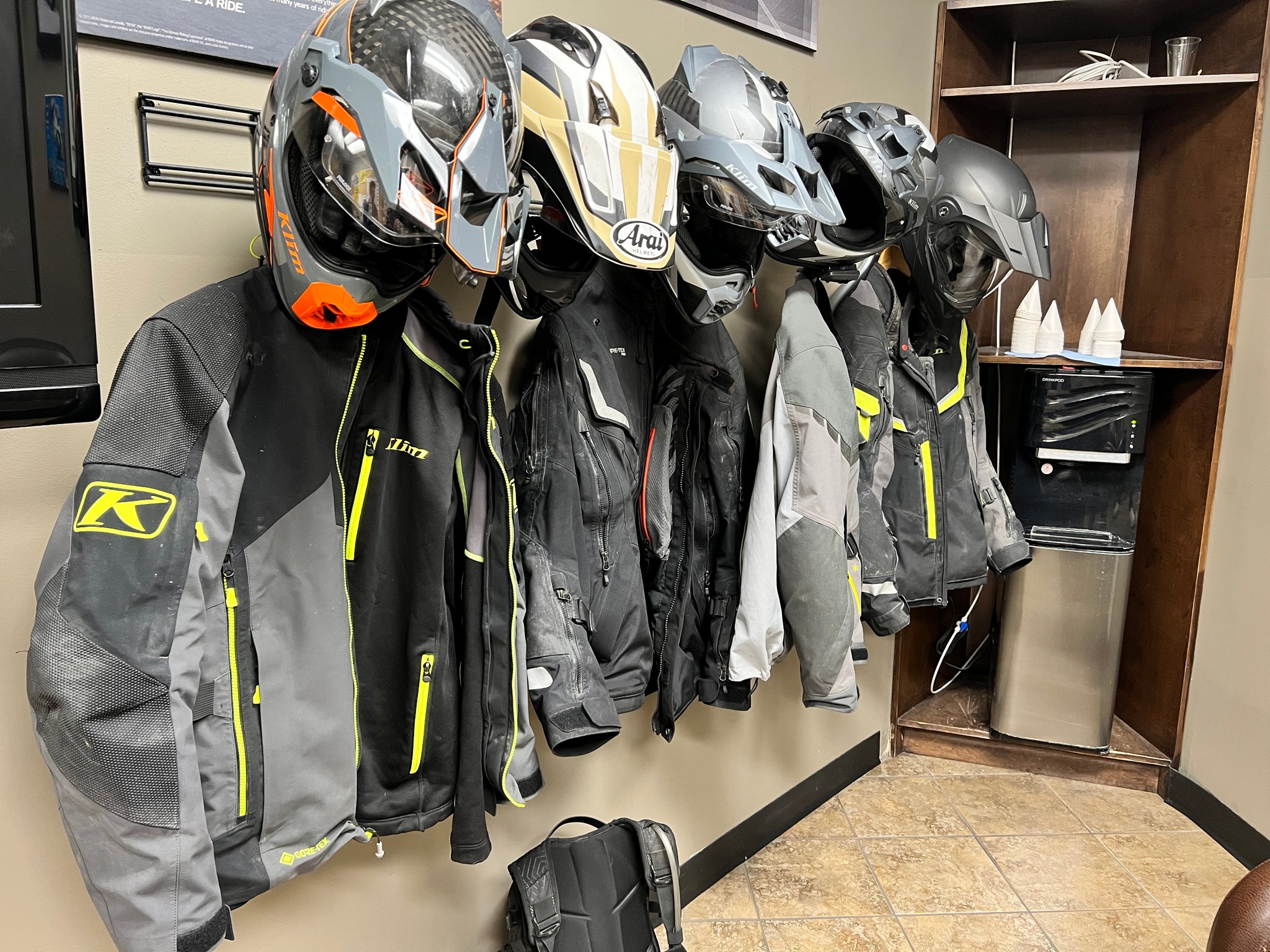
Three members of our team (myself included) wore Klim Krios Pro helmets on this trip. The Edge was an excellent fit in all three sizes (Medium, Large, and XL). I popped it in my helmet and stuck the velcro-backed JBL speakers directly to the microsuede-lined speaker pockets.
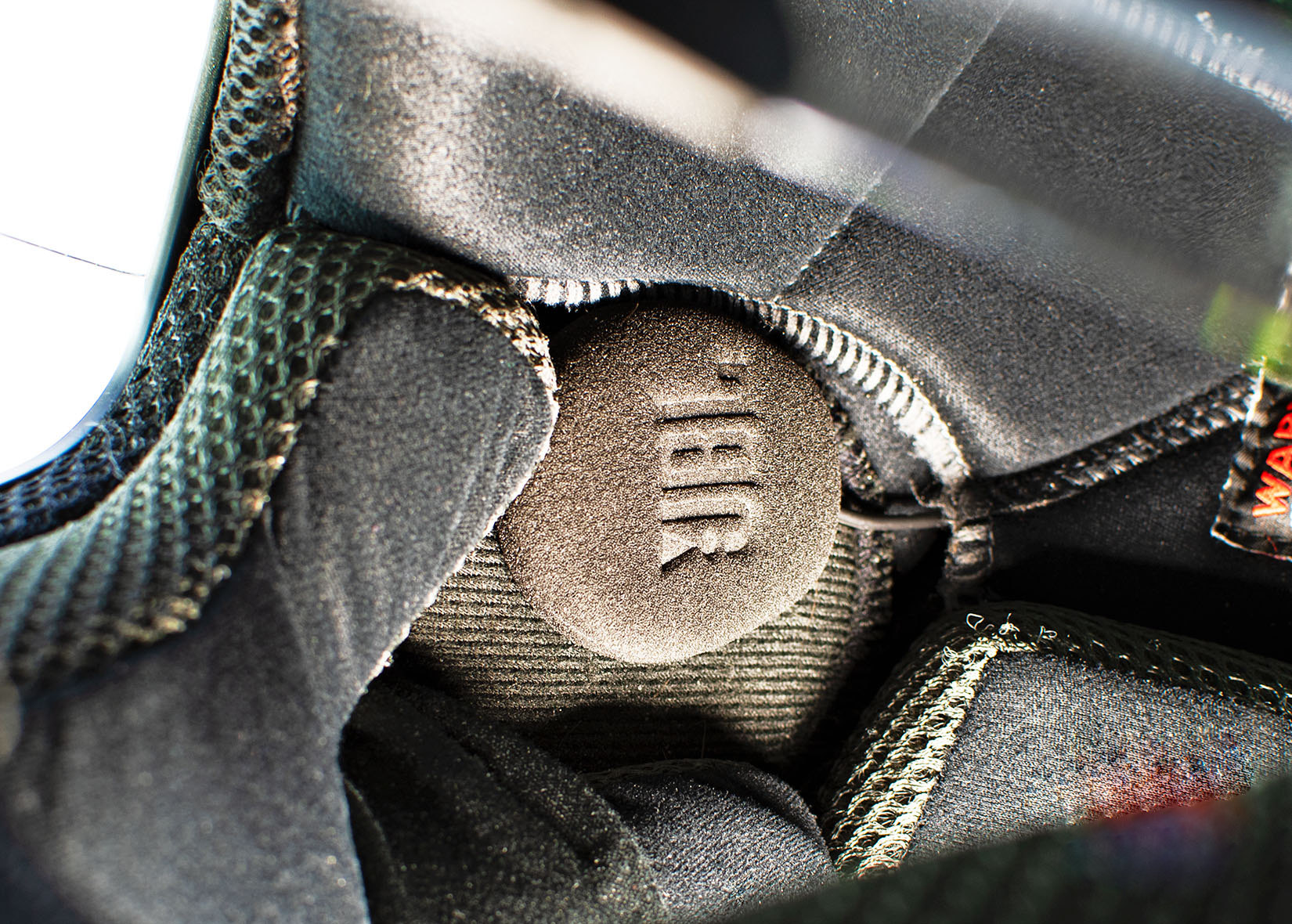
The Krios Pro has a perfect location right above the chin bar vent to mount the button-style microphone and there’s a hole in the neck roll to route wires from the Air Mount bracket on the exterior to the interior where the speaker and microphone connections are housed. Installation took about 15 minutes.
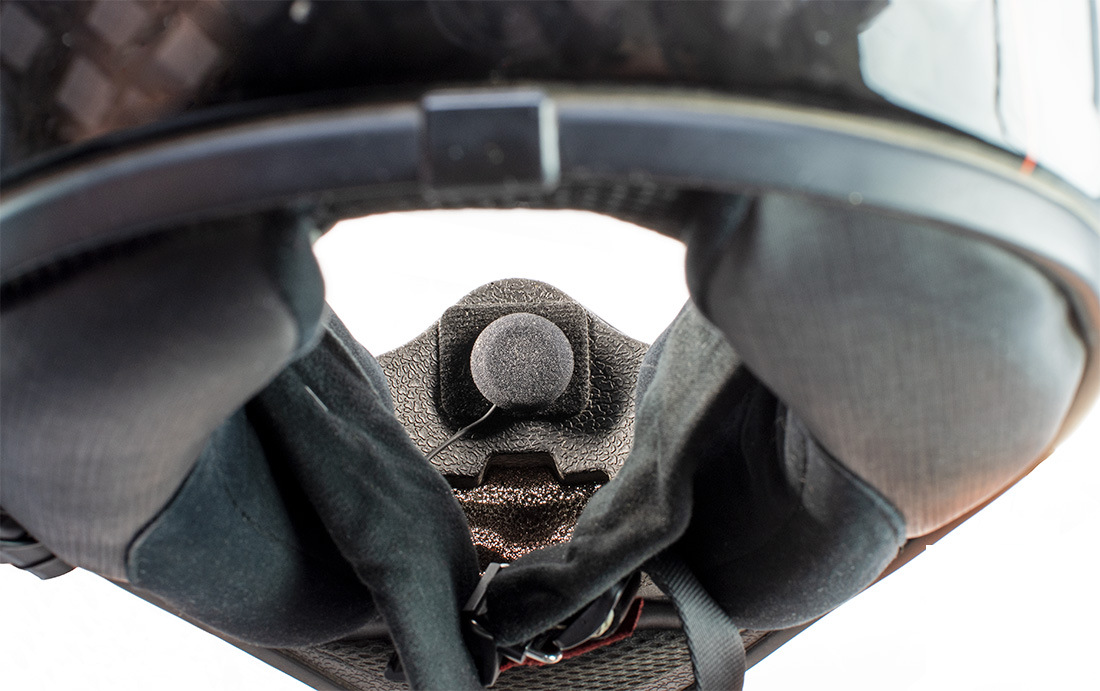
My helmet and the Cardo KTM Edge paired up especially well from a visual perspective since it has the Loko Striking Grey pattern which mirrors the orange/black KTM Edge colour scheme. It was a match made in heaven!
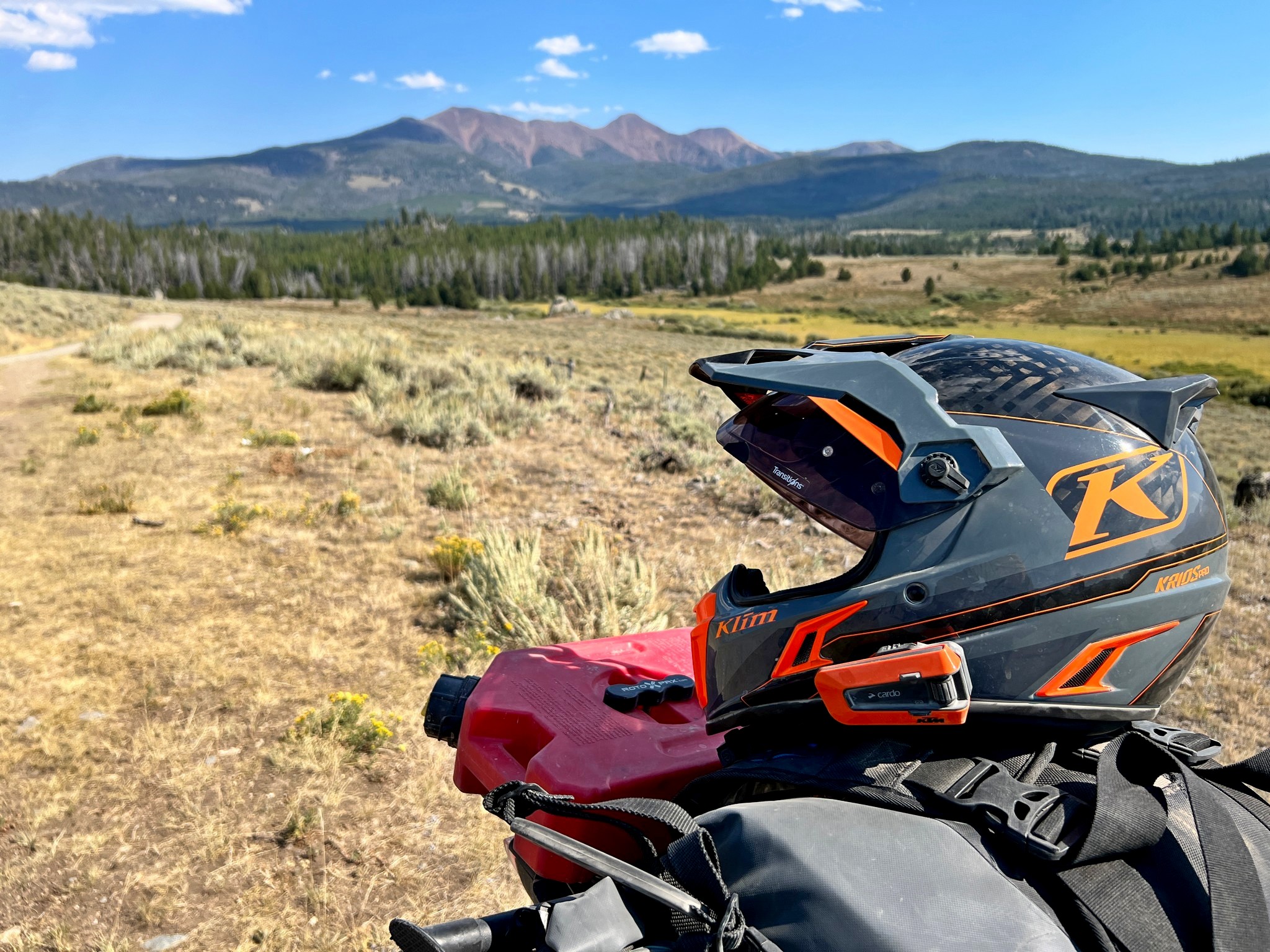
Scorpion EXO AT950
There were two Scorpion EXO AT950 modular helmets (ADX-2 outside North America) in the group. The owners equipped the boom-style microphone in lieu of the button-style mic in their flip-front lids. Again, no issues with mating the Cardo with these helmets.
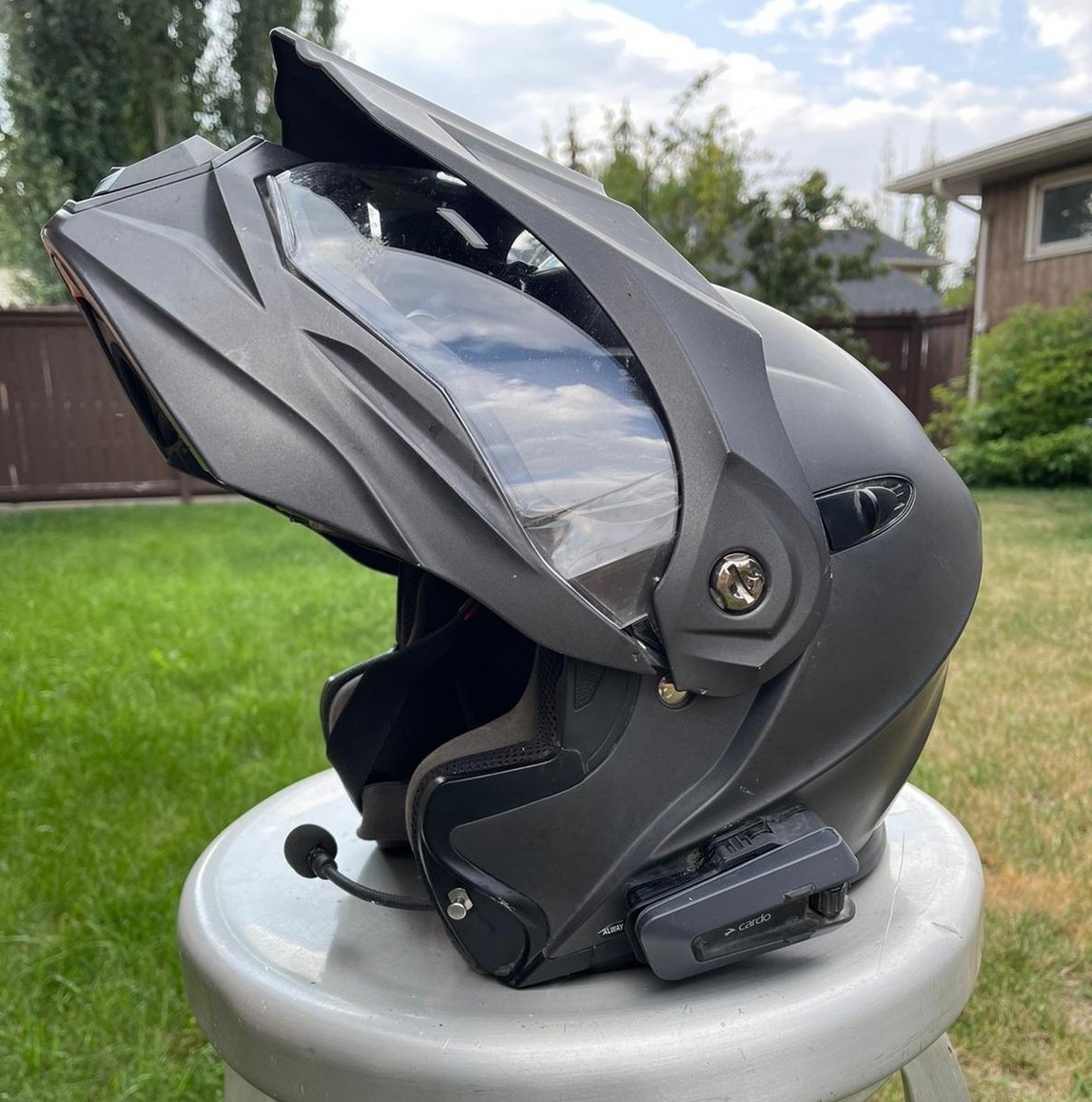
Unfortunately, one of the boom mics was non-functional right out of the box, but we had 3 spare, unused ones from the Krios Pro wearers’ kits. A warranty claim was made through the usual Cardo channels and a replacement mic arrived 4 weeks later. That wasn’t the most stellar example of a speedy replacement, to be sure, and I hope Cardo improves on it.
Arai XD-4 (Tour X4)
The Arai was the only helmet that gave us issues with the Edge installation.
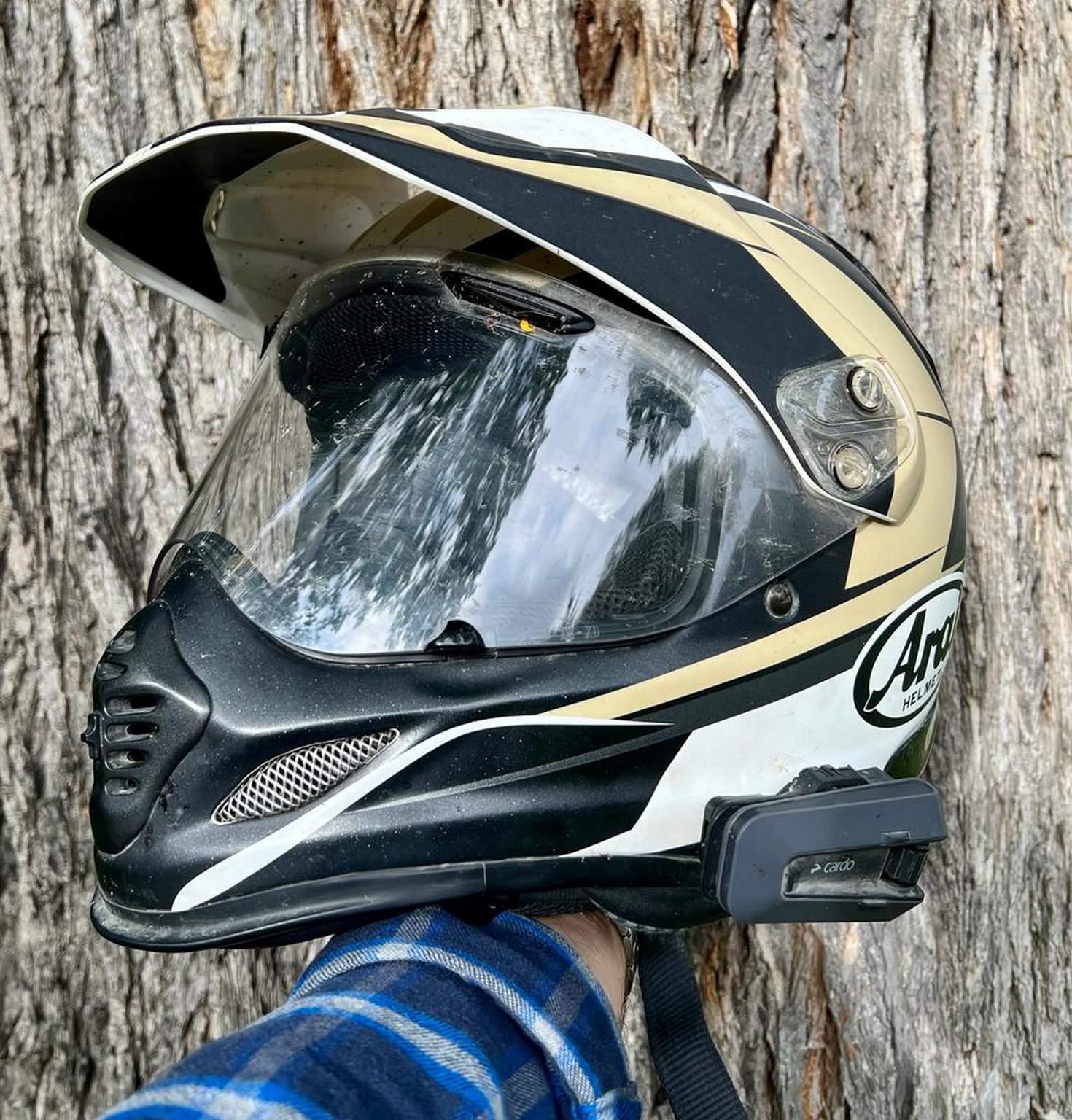
We just couldn’t find a good location for the microphone to sit where it wouldn’t be picking up some wind noise at highway speeds. We tried both the boom and button mics to no avail, and in the end, we all just learned to live with the whistling wind noise constantly accompanying Ian’s witty banter out on the road.
The same issue was there with the Sena 10C Evo microphone I experimented with in my own Arai XD-4, so I’m positive it’s a characteristic of the helmet and not a fault of the Cardo.
Quality of the Boom Microphone
We found the microphone quality to be exceptionally clear and good once the correct level of sensitivity was dialed in using the Cardo App, but the boom mics need to be placed almost inside the user’s mouth in order to be top-shelf clear.
On the Great Divide Trip, the boom mic in Ian’s Arai XD-4 was a constant struggle to position ideally because the Edge’s built-in Noise Canceling technology would inadvertently lower the volume of his speech while working to cut down the wind noise being transmitted to the rest of us.
If you have an Arai helmet you may need to invest in a better wind muffler for your microphone regardless of whether it is a Cardo Edge or something else.
A Synopsis of What Works As Advertised on the Packtalk Edge
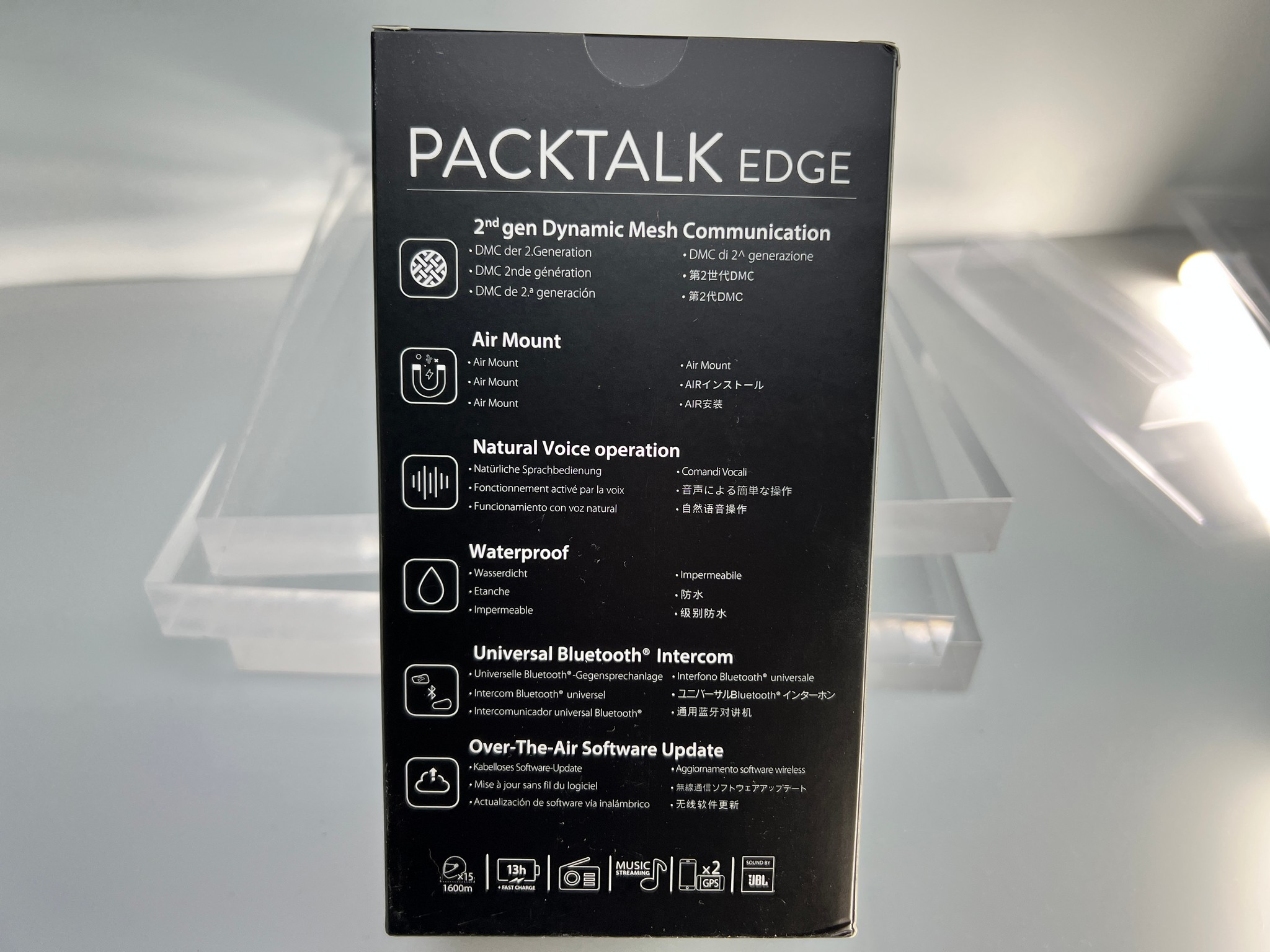
Here’s a summary list of the features we found to work very well on the Cardo KTM Packtalk Edge and base Packtalk Edge.
- It connects to my iPhone 13 Pro Max and other phones immediately once set up
- It’s slow to connect to the Cardo phone app on Android & Apple devices, but once connected, it works very well and there is a multitude of useful settings to fine-tune performance
- Firmware updates wirelessly execute when connected to WiFi or cell data
- The battery charges to full in less than 2 hrs and lasts all day even when used continuously except when using Mesh, which cuts battery life to just over half of Bluetooth levels (12+ hrs for BT and approximately 8 hours for Mesh). If you turn off the Edge when having lunch or other breaks, the Mesh intercom lasts 12+ hours as well
- The battery still reports at 50% after sitting unused for 15 days
- Installs easily in every helmet I’ve attempted to install it in
- Plays music, radio stations, podcasts, and any audio coming from my phone perfectly
- Makes and takes clear phone calls
- Activates Siri on my iPhone every time I request it verbally or using the phone button
- Connects to navigation apps or devices that work concurrently with music playing in the background
- Connects via Bluetooth intercom to other Cardo and even Sena devices
- Performed as intended in temperatures as low as 41 Fahrenheit (5 Celsius) to a high of 102 Fahrenheit (39 Celsius)
- Handled exposure to rain, dust, and dirt without issues
Those are the things that worked well on the KTM Packtalk Edge, but in the rest of this review, I’ll dive into the things that really set it apart and the areas it could improve upon.
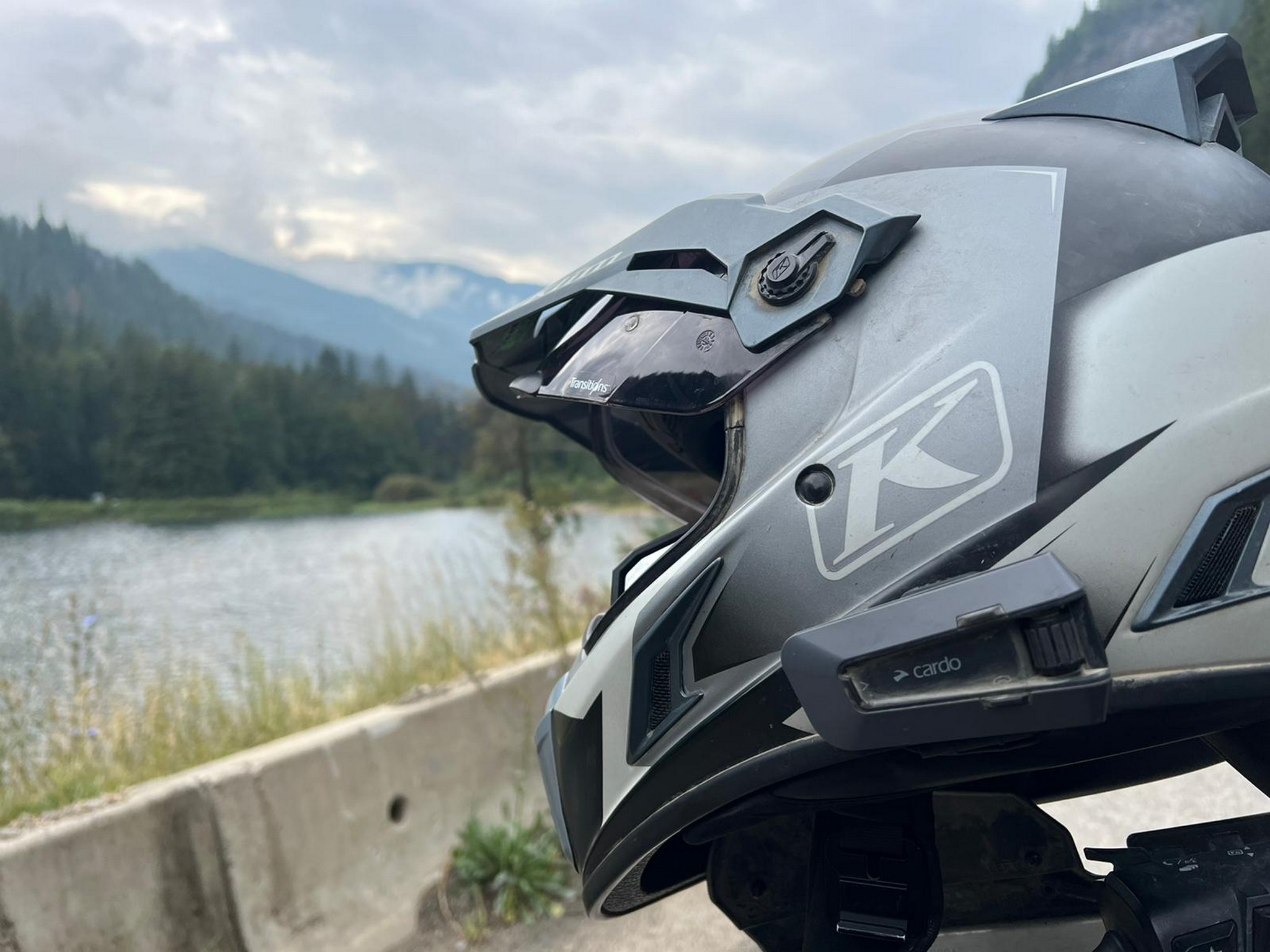
Over-the-Air Firmware Updates
The first thing to do when you remove the KTM Packtalk Edge from the box is to charge it fully, although mine arrived that way.
The second thing to do is update the firmware wirelessly… which I found to be an absolute piece of cake. Unlike other devices, you don’t need to plug it into a laptop to do this and it’s entirely painless to use WiFi or even cellular data for it.

The Cardo Voice Command Feature
Some things are so freaking good that once inserted into my life that I can’t imagine how I got by before having them. The Cardo Voice Command is one such thing.
My first Cardo device (a Freecom 4X) also had this feature and it showed me that I should never need to take my hands off the handlebars again to poke at the buttons on an in-helmet comms device.
Since that Freecom 4X, I’ve not touched a Cardo button other than when turning on or off the device’s power… with one lone exception while riding by an airport in Montana!
Airports vs. Cardo Devices
Airports are the Kryptonite of Cardo devices.
I’ve no idea what happened when I was riding home from Sturgis in July 2022, but the airport in Billings, Montana shut down all voice command functionality on my Edge. I can’t explain why, but after rebooting the device things were back to normal.
Overall the Voice Command has operated at roughly 95% accuracy in my Krios Pro helmet. Even when I mumble or fake a Scottish accent—it’s nearly flawless.
Voice Command?
This feature allows a rider to verbally manage all of the Edge functions.
You can even activate Siri or Google to do things like making a phone call. The photo below shows the list of available Cardo KTM Packtalk Edge commands.
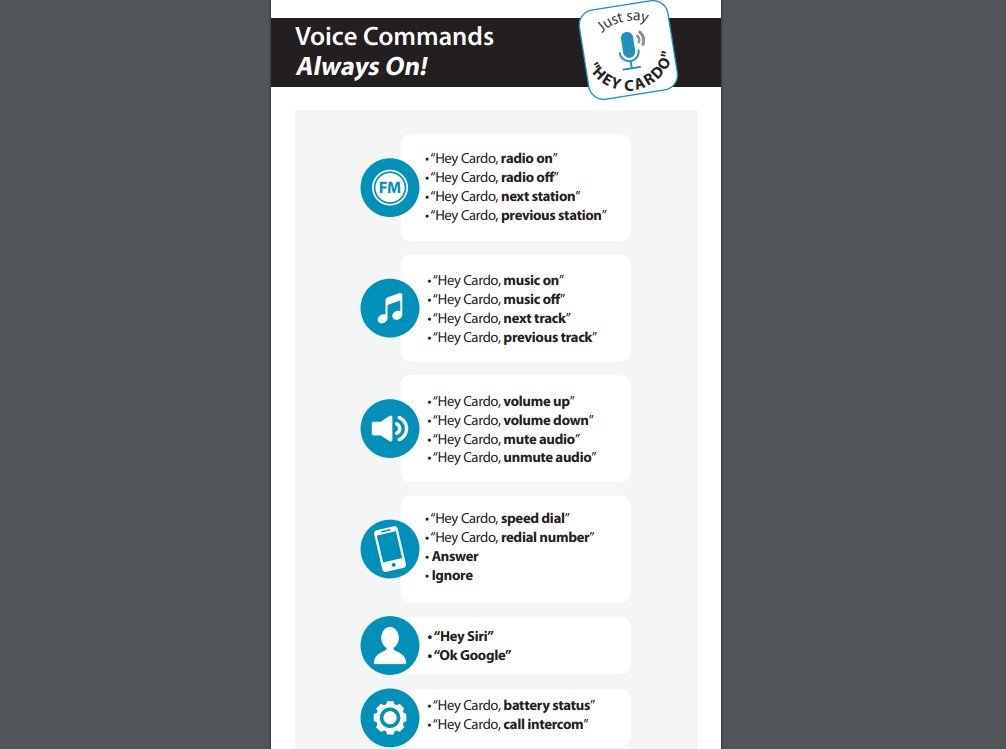
The Safest Communication Device
The Edge is safer to use than other similar in-helmet devices because it’s the easiest to control verbally.
As mentioned above, my hands stay on the bars instead of fumbling around on the helmet while attempting to find the volume wheel or phone button.
The new Sena 50 series devices also have a good voice command feature on them which can accomplish the same thing, but the user has to make a distinct pause between activating the voice command feature (“Hey Sena”) and issuing the command (“stop music”).
With the Cardo Edge, you can string both parts together into one, run-on sentence. A minor difference to be sure, but it’s easy to appreciate when you’re trying to quickly shut off your music when your significant other, or a police officer is trying to speak to you out on the road.
USB C Charging Cable
Another small advantage the Cardo KTM Pactalk Edge has over the competition is its USB type C connector which can plug into the device both ways.
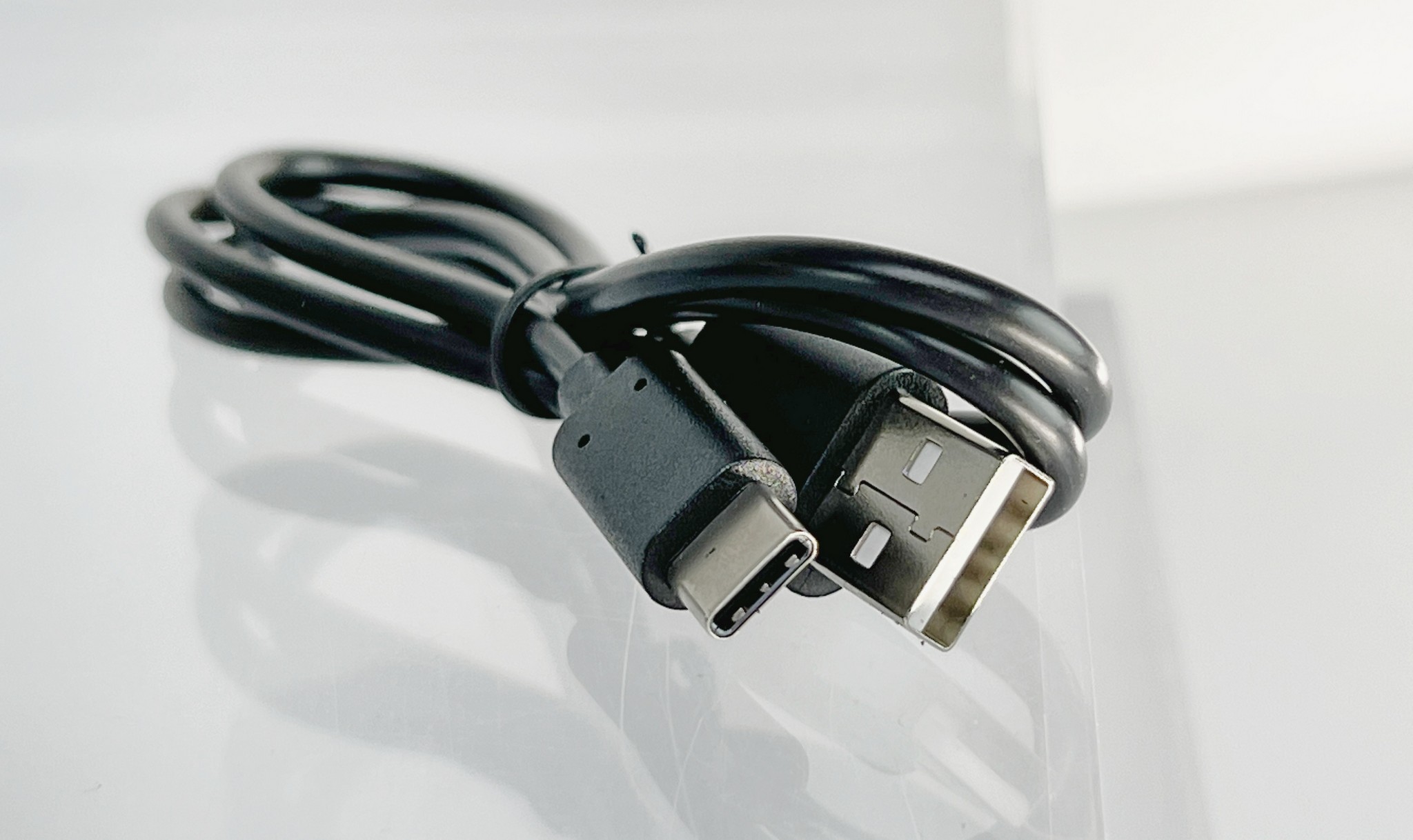
My Sena devices sometimes frustrate me when I’m attempting to get the charging party started because its USB mini connector only fits in one way without damaging the charge port.
The PackTalk Edge Intercom Connects Easily to Sena Devices
The Cardo Edge is a cut above the competition when it comes to playing nicely with non-Cardo devices. It can trick my Sena 10C EVO and 20S devices into thinking it’s a smartphone when it comes to establishing a Bluetooth intercom grouping. Doing that makes the Sena devices pair up immediately when asked to make a Bluetooth intercom connection between them.
The way to do it is to initiate a standard Bluetooth intercom connection using the Cardo app and then activate the phone pairing feature on the Sena. They’ll link up and you can chat while out on the road.
This is a huge draw if you ride with friends who don’t own a Cardo device because getting earlier Cardo and Sena devices to connect successfully has been so difficult that I’d just give up after multiple attempts.
The JBL Speakers in the Cardo KTM PackTalk Edge
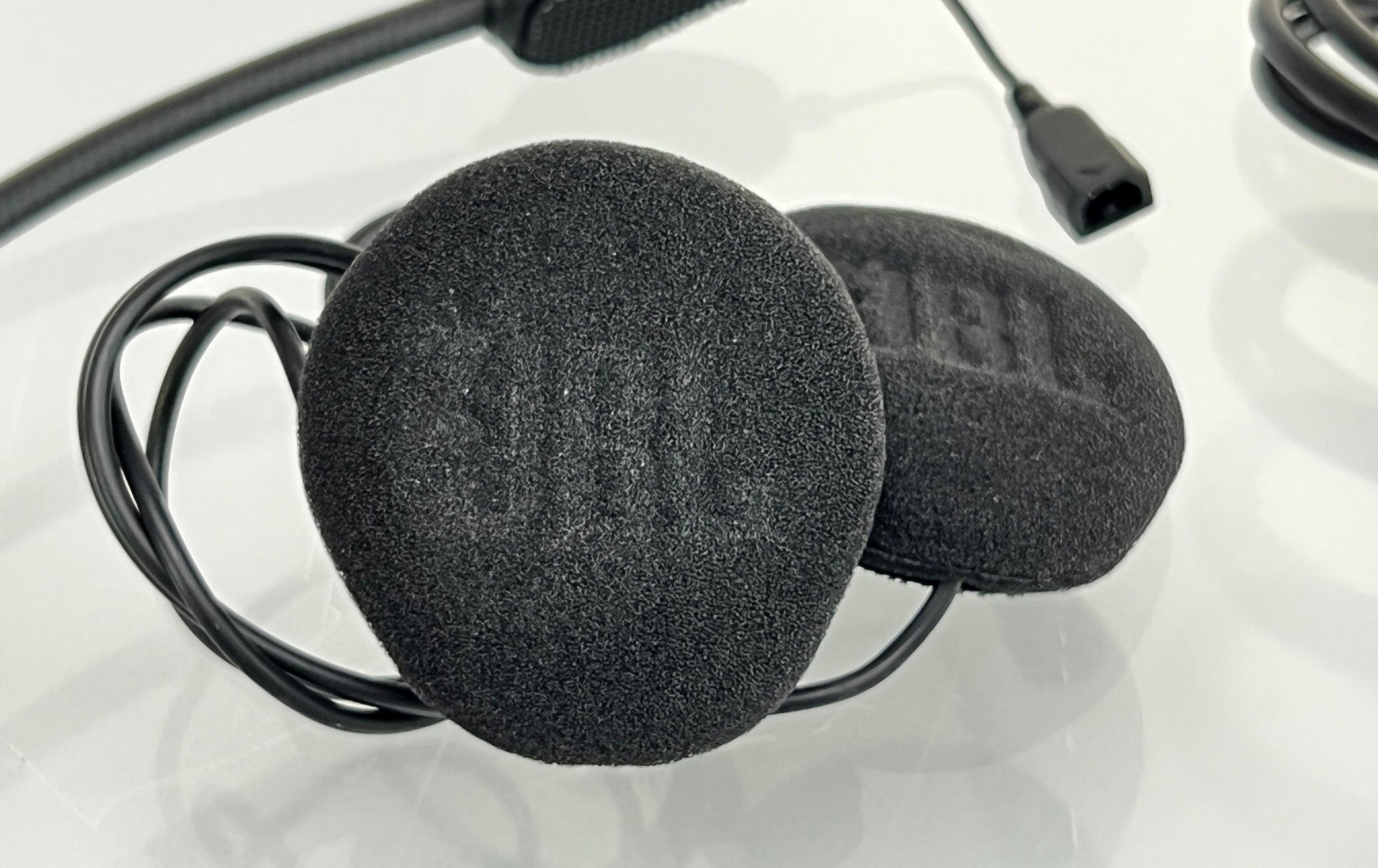
Cardo 40mm JBL speakers and Sena’s HD speakers sound comparably close in quality and clarity, but I give the JBLs the “edge” at higher volume.
It’s possible to upgrade the 40mm speakers to JBL’s 45mm speakers for $90 US if you’re a complete and utter audiophile who insists on having the best of the best. I haven’t yet tried the 45mm speakers, but thus far the 40mm ones have met or exceeded my requirements.
Charging the KTM Edge While in Use?
No problem charging on the fly with the KTM Packtalk Edge. This is a big deal if, like me, you ride 10 to 12-hour days… or on occasion forget to charge the night before.
The Packtalk Edge “Air Mount” Mounting Plate
The KTM PT Edge housing will jump through the air and attach itself to the Air Mount cradle when moved within 2 inches of the intended landing strip thanks to the power of magnetism.
Magnets draw the two halves together but it’s a plastic latch that securely bonds them as one. Never once over the 5000 miles ridden over rough and smooth terrain did any of my riding group’s Edge devices separate from the Air Mount. Cardo did an excellent job with this design even though I worry at times I’m about to break the plastic latch when releasing the device from the Air Mount. The latch feels on the flimsy side but thus far refuses to break or bend.
In fact, removing the Edge from the Air Mount is a two-handed endeavor for my clumsy meathooks.
The Air Mount Might Become An Issue Over Time
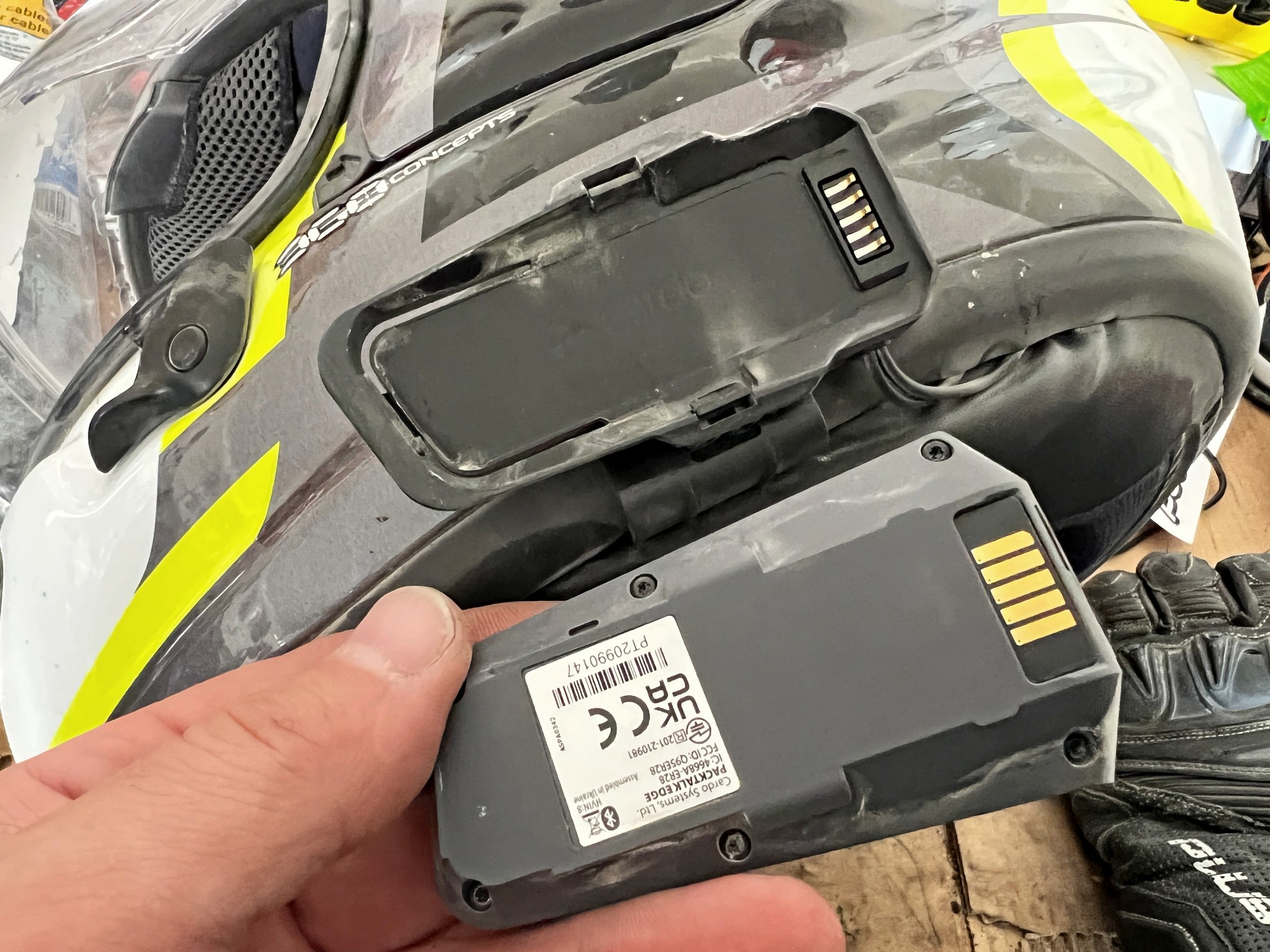
Each time I charged my KTM Edge, I removed it from the cradle and cleaned the two surfaces to prevent wear and tear on it. The two halves are installed so close together that they seem flush but I found traces of fine dust inside. Water will get in between them as well (as seen in the photo above).
It’s my observation that the members of my riding group who followed my lead (cleaning when charging) versus those who left the devices coupled when charging them experienced fewer electrical glitches.
Interestingly, the dust and water never did manage to invade the electrical connectors on my device thanks to the improved seal Cardo put around them.
Electrical Glitches?
Electrical issues were few and far between on the 6 Edges tested on the Continental Divide Ride my group completed, but I’ll mention the examples found here anyway. This is in addition to the airport phenomenon already mentioned.
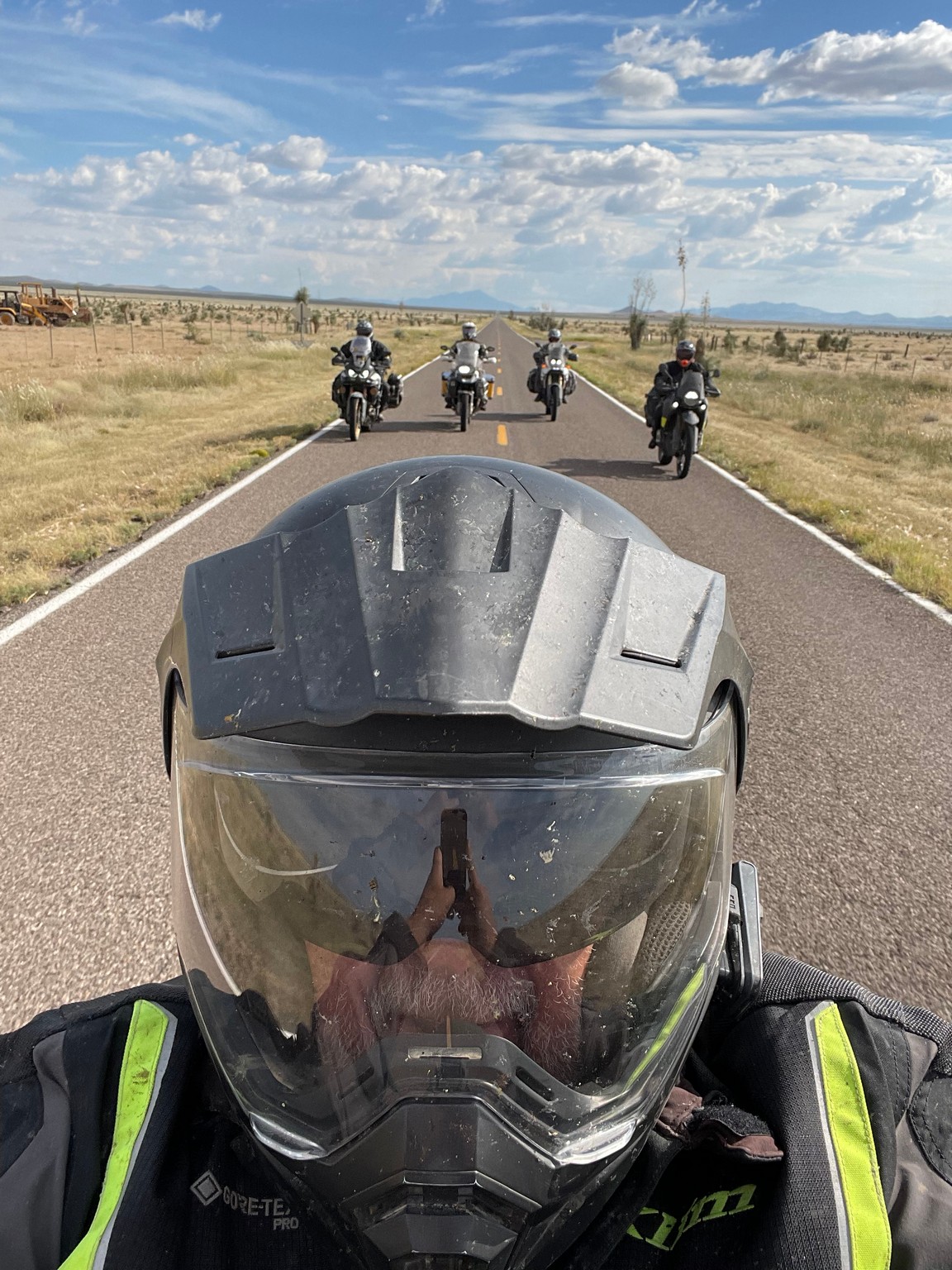
Intercom Issues
The intercom usage in our group was 100% of the Dynamic Mesh variety because Bluetooth wouldn’t allow 6 of us to be linked together all the time. We found riders 4 through 6 in the group wouldn’t hear complete sentences from rider 1 if there were hills or other large barriers between the front and back of the group. It was necessary to have rider 3 repeat important information and only then would the signal be clear for all.
Occasionally the gap between the front and back of the group would grow too large and someone would drop out of range, but the Mesh pairing would instantly heal anytime line of sight was re-established. The range astounded us at times! We easily could have 2 miles between the front rider and rear rider with crystal clear audio if there weren’t too many large barriers in the way.
Boom Microphone Issues
As mentioned one boom mic didn’t work at all out of the box, but the same rider also had an isolated issue with the replacement boom mic in his Scorpion AT950 helmet at the two-week mark.
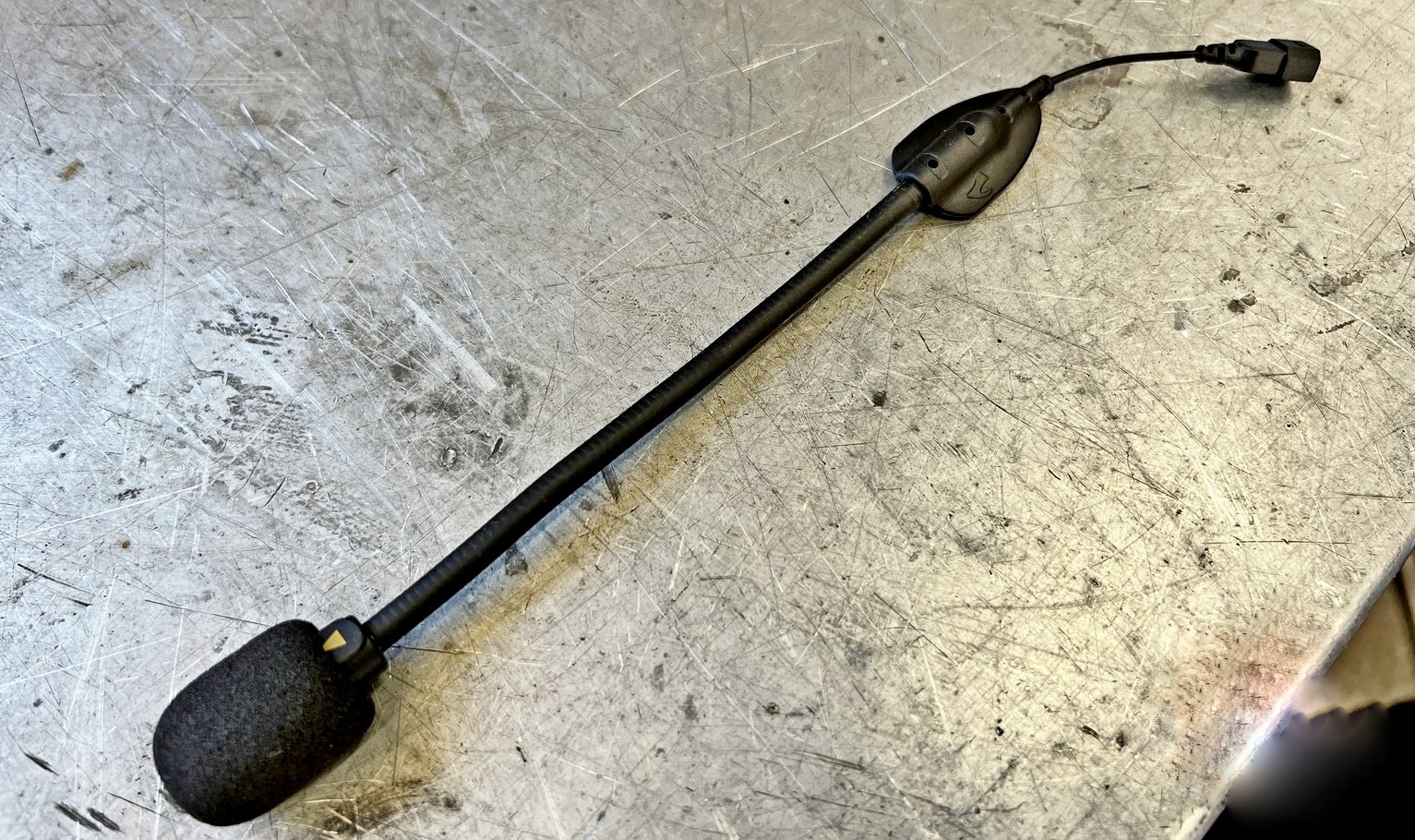
We don’t know why, but at the beginning of the day, his mic simply wouldn’t work at all until we unplugged the 3mm connector and rebooted the Edge device (switched off then back on). Not a huge problem in reality, but worthy of noting along with the fact that none of the button-style microphones experienced any issues whatsoever.
Static
Noise wasn’t a problem with any of the devices as it has been with some of my Sena 10C EVO, 20S, and 30K devices. These Cardos just seem to do audio better overall although I haven’t tried the Sena 50 series yet to comment on the latest generation of comparable Senas.
How Can The KTM PackTalk Edge Be Better?
Charging Light Indicator
The charging light indicator glows red while the device is charging but then switches off entirely when the battery reaches full. I’d prefer it to glow green when fully charged to let me know it was successful with a glance.
Alternatively, I’d like a visual battery life gauge on the device, even though whenever the Edge is switched on or off the battery status is verbally announced to the wearer.
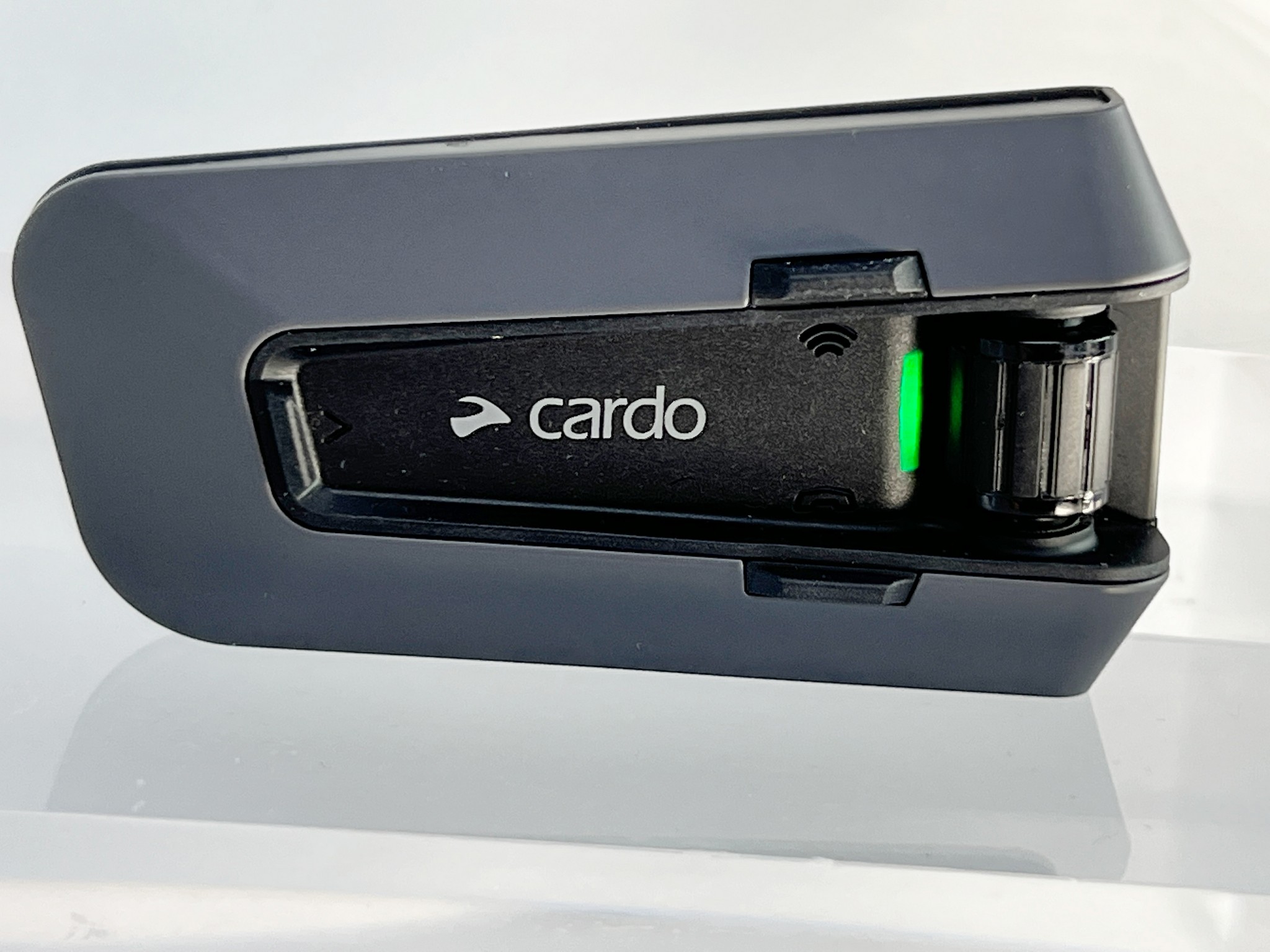
Microphone Wind Muffler
The microphone has a foam wind muffler on it but this is largely inadequate for helmets like the Arai XD-4 which channel wind at the wearer’s mouth and muck up the audio quality. A “dead cat” style muffler would help deal with this problem.
Connecting Intercom Groups
The Cardo App is better than the Sena App in almost every way except one: connecting intercom groups. Cardo should copy Sena and have an individual QR code on each person’s phone app that gets scanned using the camera on the group creator’s phone to establish the desired connections.
Charging Port Seal
The charging port seal is easy to accidentally leave open when charging is finished. Once properly closed it stays put to keep water and dirt out at least.
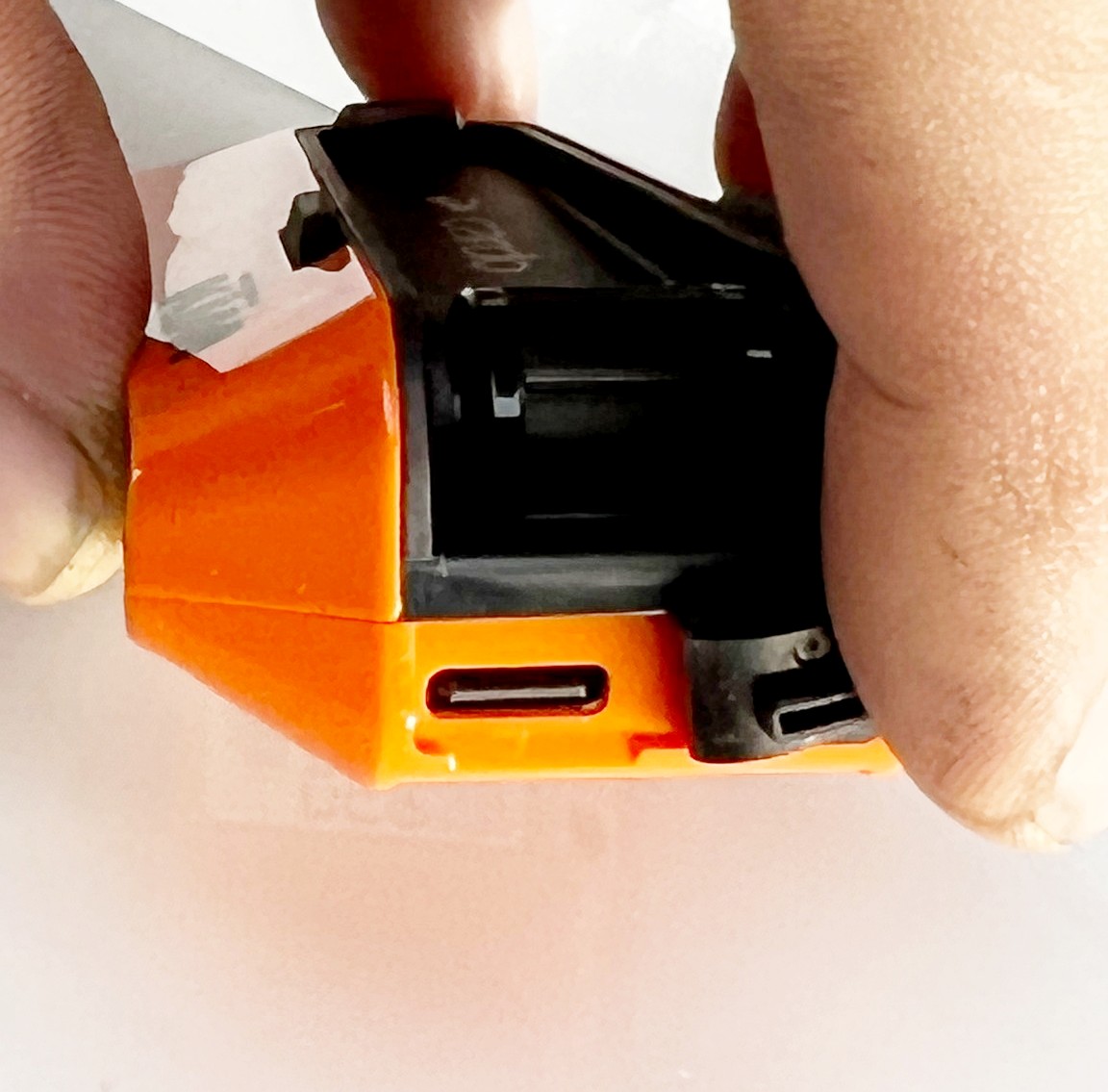
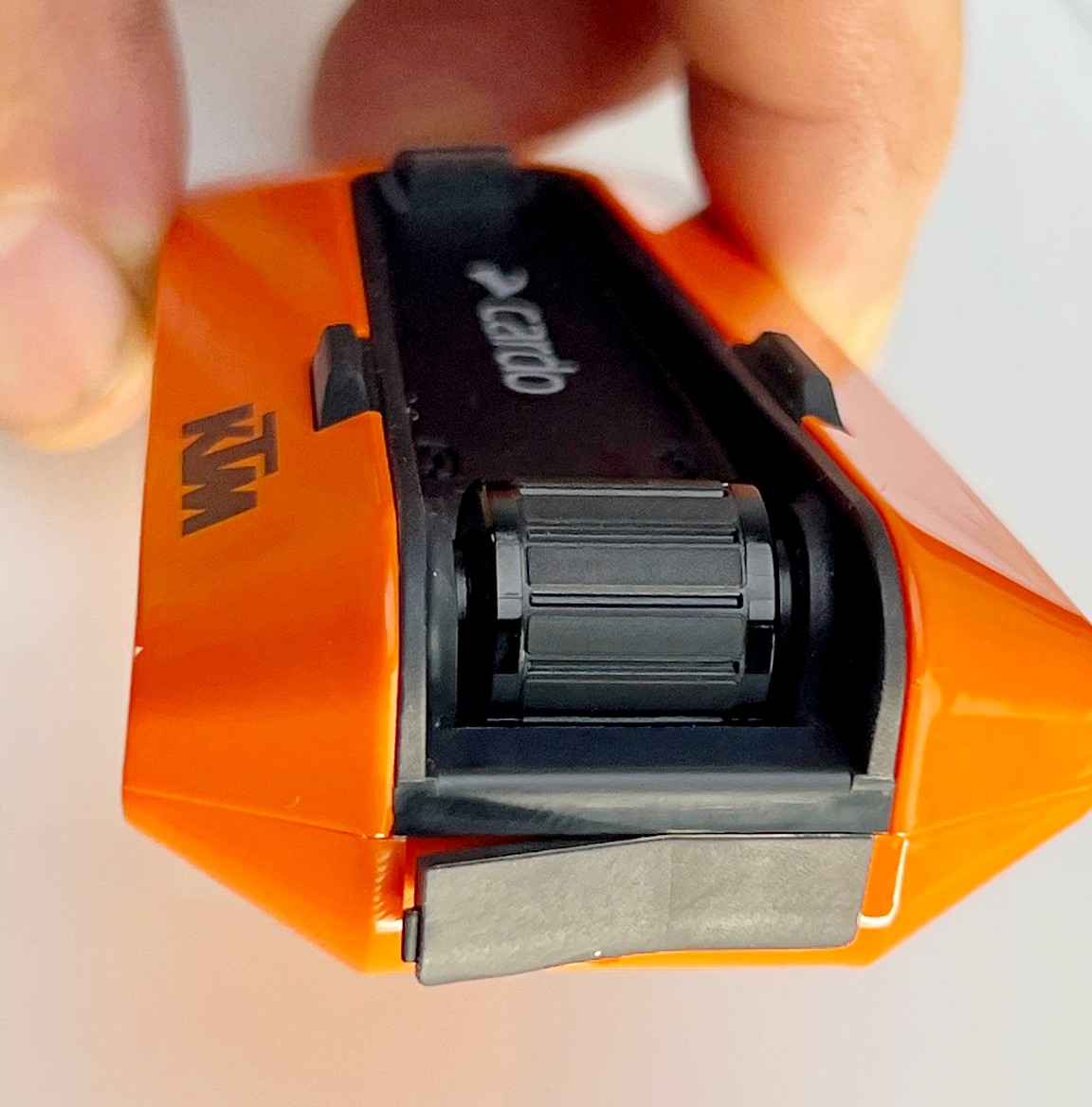
Backwards Compatibility
The Edge will connect with older Packtalk Bold and Black devices for intercom, but in order to do it the newer Edge will need to create the group and then have the older devices connect to it. Doing the inverse has resulted in frustrated Edge owners due to incompatibility. I confirmed this with a couple of my friends who own Bolds but it wasn’t an issue for me to be the intercom group creator. YMMV of course.
Final Thoughts on the Cardo KTM Packtalk Edge Communicator
The KTM Pactktalk Edge is a device for people like me: KTM fans who don’t already own a Cardo Packtalk Bold or Black. The wireless firmware updates and awesome voice command features set it above all competitor devices I’ve used and the KTM livery is the exclamation on the “love it!” recommendation I am happy to label it with.
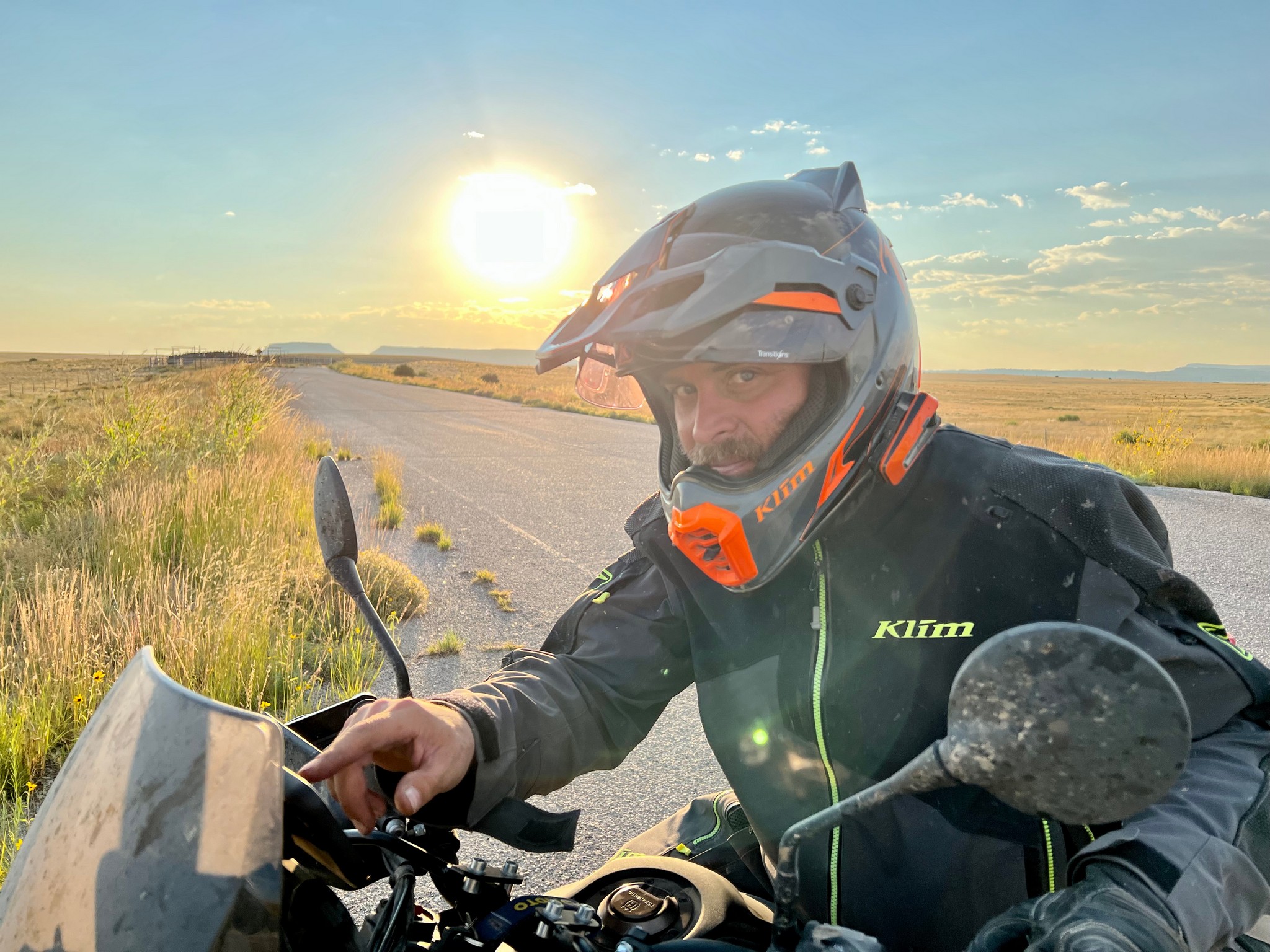
The only good reason I can think of to buy a Sena or other brand is if you want a built-in camera on your helmet communicator. That’s where the new Sena 50C might have the advantage or edge over the Edge, if you know what I mean.
Hopefully, Cardo will soon build a device to compete with Sena in that regard.
Cents and Sense: The Value of the Packtalk Edge
The KTM PT Edge is (sometimes) $30 more expensive than the base model PT Edge. This is annoying, but understandable since KTM isn’t in the habit of letting their logo get used for free. Although at the time of this writing I see Cardo has dropped the price of the KTM Edge to $389 US making it the same price as the base model Edge.
The KTM Packtalk Edge is impressive but not the best value in Cardo’s lineup.
People looking for the best value should instead cast their gaze towards the Cardo Packtalk Black.
The Packtalk Black can be had for $350, has the upgraded 45mm speakers, still has Dynamic Mesh, Voice Command, and the majority of the same features as the PT Edge. The Black lacks the unnecessary but nice-to-have Air Mount but so what? The only real downside to it is the missing wireless firmware updates, thus having to use a Cardo-specific cable to upgrade the software on it using a laptop.
Food for thought…
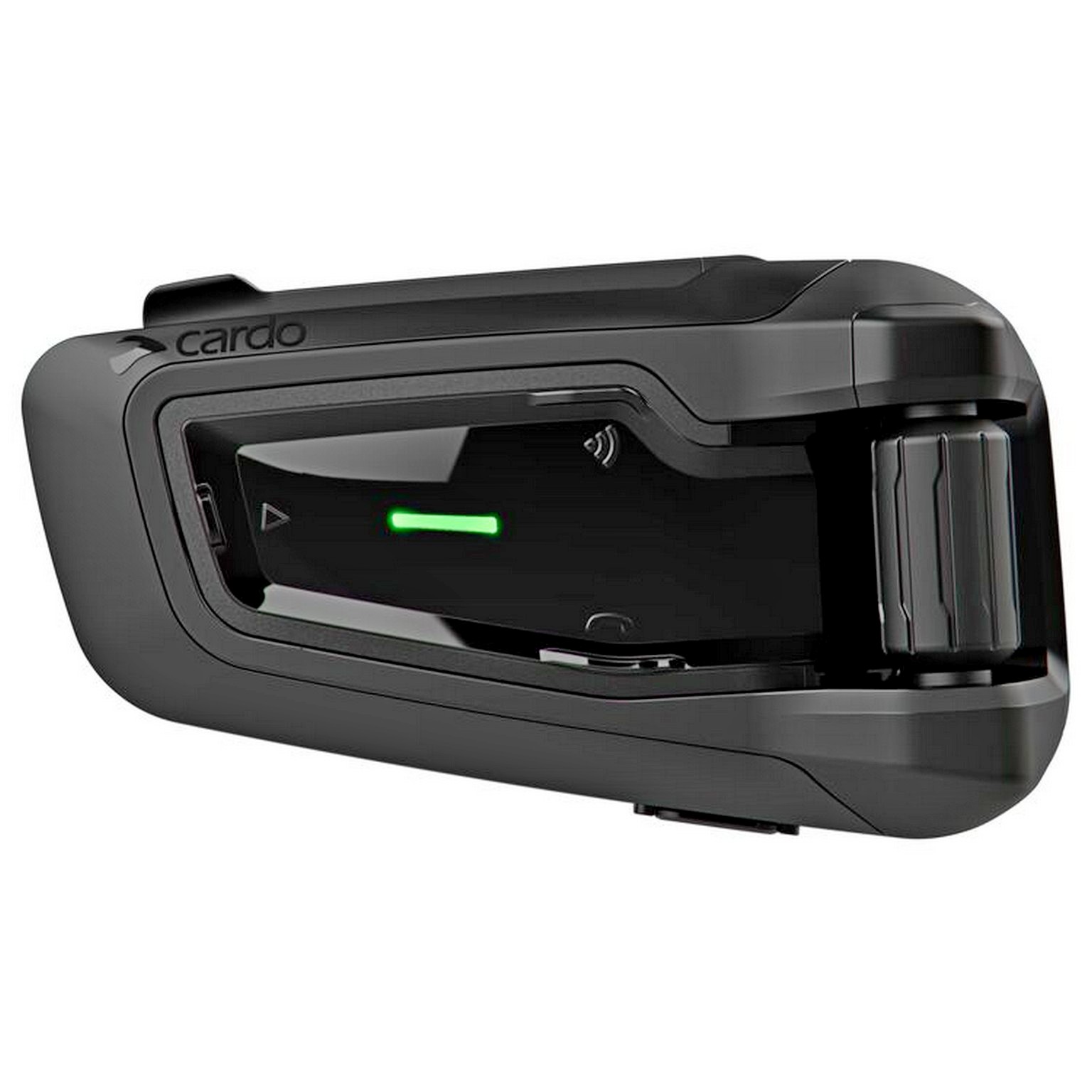
For myself, I’d wait for an end-of-the-season sale and buy myself a KTM Packtalk Edge because it’s far too easy to misplace the original charging cable for the Black. Apparently, only the original cable or specific ones like it can be used to update the Black and Bold.
Maybe I’m just too fancy for my own good, but I’d pay $40 more for wireless updates and an orange housing.
Specs
- Manufacturer: Cardo Systems Ltd
- Price When Tested: $389 US
- Assembled In: Ukraine
- Colors: Orange/Black
- Review Date: September 2022
Important Links/Where to Buy
Source: MotorbikeWriter.com

